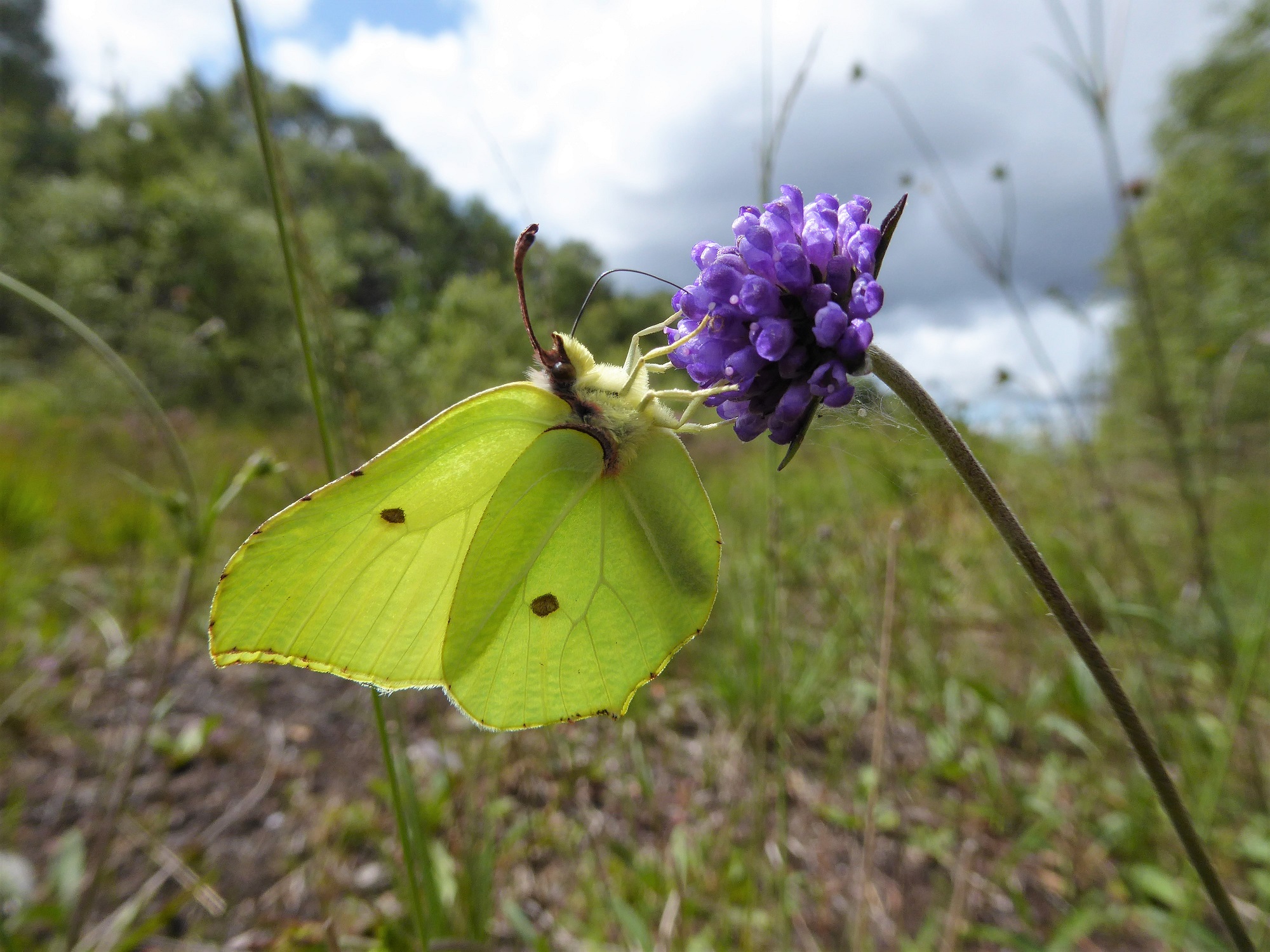BUTTERFLY CONSERVATION IRELAND ANNUAL REPORT 2020
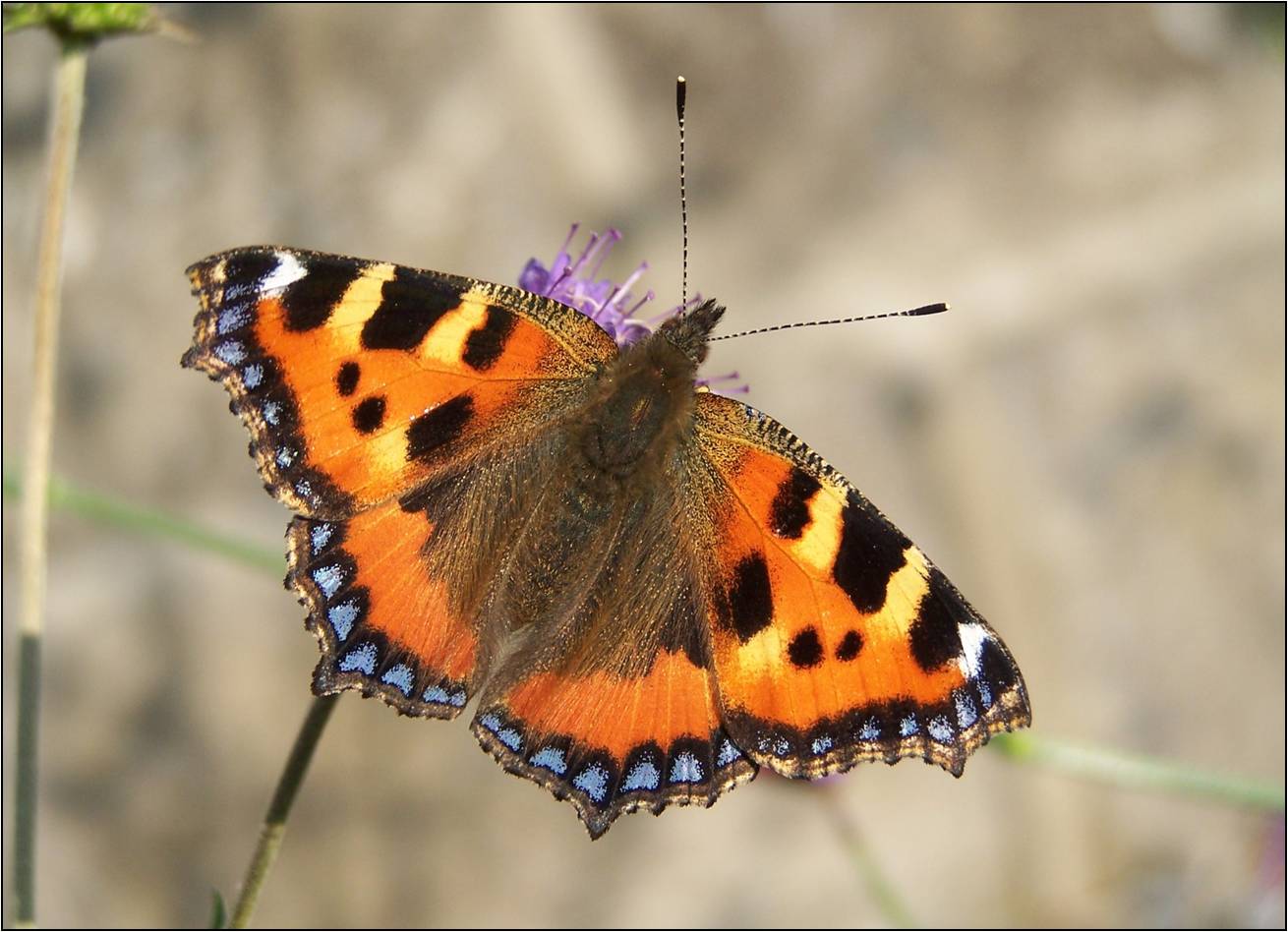
CONTENTS
• Introduction
•Butterfly of the Year
• Butterfly Season Report
• Events Report
• Crabtree Nature Reserve Report
• Conservation News
• Garden Survey Report
• A Moth or a Bee?
• Butterflies of South Korea
• Patrick Sheridan: An Appreciation
INTRODUCTION
Dear Butterfly Conservation Ireland Member,
Welcome to Butterfly Conservation Ireland’s Annual Report 2020. The year had beautiful dry, sunny weather in March, April and May but June, July and August were frequently overcast. September was a pleasant, sunny month while October was sunny but cool. Accordingly, we saw great butterfly activity during spring but lower numbers afterwards. Our reserves performed very well thanks to your support and hard work put in by our volunteers and friends. Our small staff are fortunate in having excellent support from our active membership whenever help is needed in these endeavours. Butterfly Conservation Ireland’s membership grew again in 2020, reflecting perhaps the growing concern for the environment and owing to the increased interest in nature that has arisen under the coronavirus pandemic restrictions on movement.
In spring, people noticed butterflies and other wildlife more than usual, adding a much-needed boost to morale and a relief from the remarkable pressure and distress many of us have suffered. Your continued practical and financial support is greatly appreciated as we strive to ensure that our butterflies and moths continue to have an important voice for their conservation. We pursue the conservation agenda at every opportunity with many submissions to government bodies concerning our habitats. Our recording scheme continues to provide important quantitative and qualitative data; let’s see if we can maintain this in 2021. Our financial accounts were approved thanks are due to our joint treasurers Michael Jacob and Joseph Harding. Thanks are due to Richella Duggan, John Lovatt and Pat Bell for help in editing this report and to all who contributed to its contents and to all of our members and supporters. We hope that you enjoy reading our Annual Report and we look forward to hearing from you in 2021.
Yours in nature,
Jesmond Harding (Secretary)
Butterfly House
Butterfly Conservation Ireland
Pagestown
Maynooth
County Kildare
BUTTERFLY OF THE YEAR 2020
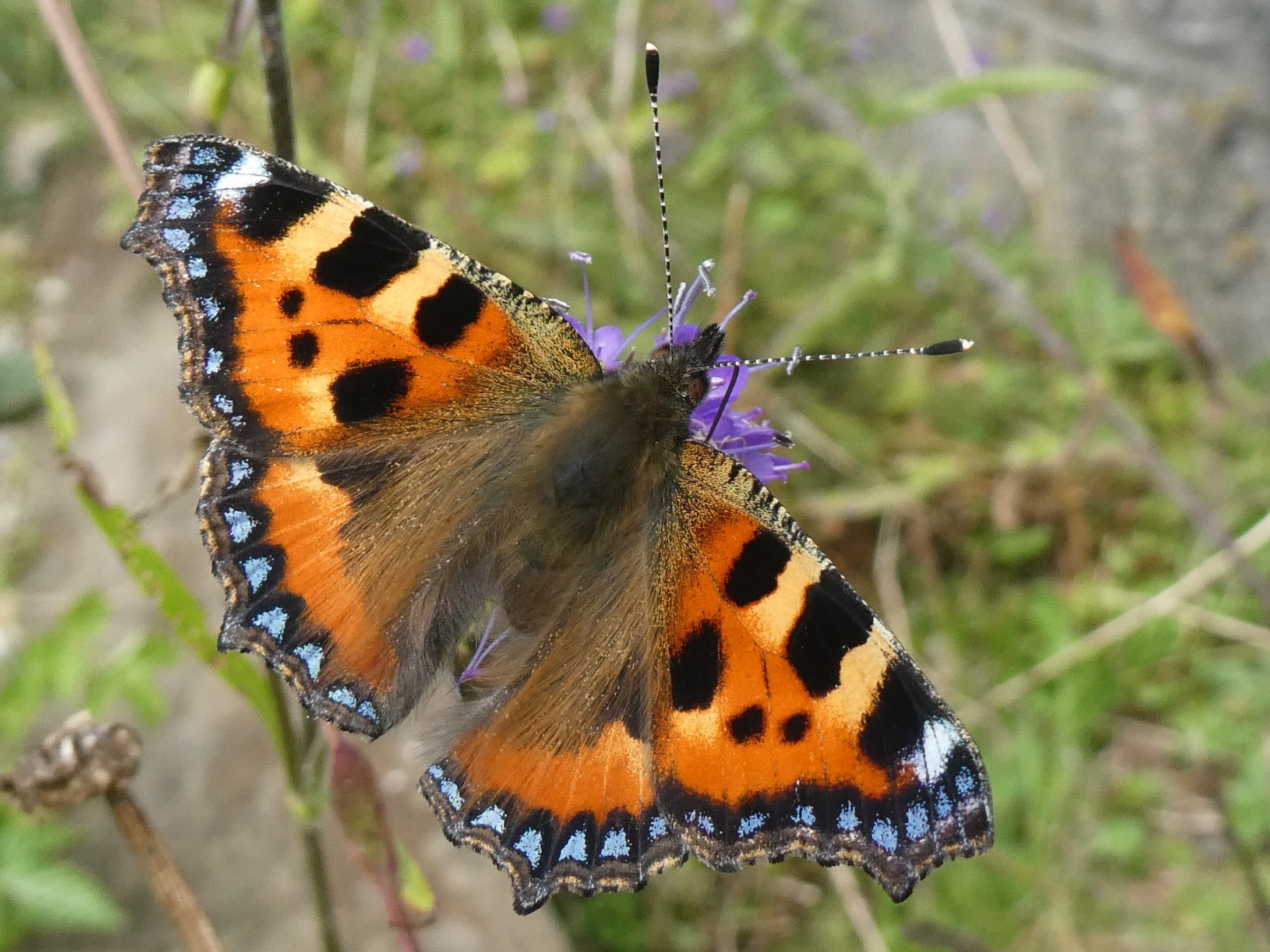
For certain butterflies, sometimes a year can go without a hitch. A wet February was followed by a lovely, prolonged almost rainless spring with warm sunshine on most days in April and May. These conditions helped the Small Tortoiseshell butterfly to launch its year. This article reviews its fortunes during 2020 and concludes by looking at just some of the challenges that confront this beautiful butterfly.
When it wakes from its hibernation in spring, the Small Tortoiseshell needs warm weather to fly. The butterfly needs to feed, find mates and the females look for more nectar to develop their eggs and then seek suitable breeding sites. The larval foodplant, the Stinging Nettle, is not well developed in March and early April so the females must continue to feed to develop their eggs. When she is ready to start laying her eggs, it is vital that suitable nettles exist for egg-laying. By mid-April the nettles reached a suitable size. The sunshine helped females that had laid their first egg batch to take nectar to develop further egg batches and disperse to find new breeding sites. The eggs, larvae and early pupae developed quickly in the warm sunshine during May, with the first new-generation adults observed by early June.
After very hot weather during the first week in June, the rest of the month saw above-average rainfall but temperatures near the average for June. This helped because a continuation of the drought conditions that developed over the spring months would have reduced the suitability of the nettles. These were now refreshed, and grew strongly, making for excellent breeding conditions for the vast number of Small Tortoiseshells that emerged during June and July. Most of these butterflies stayed close to nettles and bred. The offspring of these mid-summer breeders appeared in very large numbers in many areas.
Unlike their grandparents in spring and parents in mid-summer, most of the second generation will not have bred in 2020. It is their need to feed heavily in preparation for a long overwintering period that brings them to our gardens. Seeking nectar, the butterfly turns up in warm, flower-rich, sheltered areas near suitable overwintering sites where they settle to feed in advance of hibernation. Their focus on feeding without expending much energy makes them very easy to approach with some so docile that they can be touched without taking flight.
These make for lovely viewing and there have been spectacular numbers, with hundreds seen at Pollardstown Fen, County Kildare on August 30th and also around 400 on the bog at Lullymore and Lullybeg in County Kildare. Apart from these high numbers many were observed in low numbers flying across fields, lakes, parks, roads, and the general countryside in their search for food.
The weather conditions we saw in late August and in September with mild air and good sunshine was of great benefit to this overwintering generation because they had the conditions needed to move to good sites, feed and seek places to see out the colder months.
The high abundance of the Small Tortoiseshell from mid-August was quite short-lived. A butterfly that needs to survive for several months in the adult stage cannot expose itself for too long. The habit of feeding in large groups makes it an easy target for insectivorous birds, especially members of the tit family, robins and wrens. The Small Tortoiseshell slows down at this stage (its increasing weight and falling temperatures make it heavier and slower), making it easier to approach and catch. In short, it spends only a few weeks feeding before hibernating until next spring.
During September numbers declined, although newly emerged individuals that arise from eggs laid later in summer, probably by late-emerging or older females appeared later in September and early October. Some of these October butterflies may represent a small third generation, meaning that their parents that emerged during August bred rather than attempting to overwinter.
Up to three generations of the Small Tortoiseshell may overwinter in some years. Indeed, some of the first generation of Small Tortoiseshells that arose from eggs laid last spring did not breed in June and July but entered hibernation. These are probably few in number in most parts of Ireland, but this overwintering strategy of some first-generation adults is implied from observations made of adult behaviour in Counties Dublin, Meath and Donegal. Therefore, there may be three generations of the butterfly in hibernation over the winter.
Regardless of which generation the butterfly is from, it enters our attics, sheds, outbuildings, homes, woods, dense scrub, caves and other sites that will shelter it until spring.
When they awake in good weather, usually later in March we are looking at butterflies that range in age from five to eight months. We are also looking at siblings, aunts, uncles and cousins on the wing at the same time. This does not necessarily mean that all of these individuals will breed with each other because the Small Tortoiseshell is a mobile butterfly that will travel to seek mates and breeding sites. However, in Britain, it has been found that the butterfly does not travel large distances across the country because Small Tortoiseshells from different regions show a different response to day-length. Thus, larvae that were taken from Scottish populations always produced adults that delayed breeding until spring, irrespective of the amount of daylight they received. In the south of England, the butterfly has shown the ability to produce three generations.
There is much more to learn even about common butterflies like the Small Tortoiseshell. A study in the UK found that much of the variations in the Small Tortoiseshell’s phenology (the study looked at emergence peaks) are unrelated to temperature or latitude (Hodgson et al. 2011). Whether a similar study carried out here would show a similar result is unknown. However, the UK study did not take account of various effects of winter minima and summer maxima temperatures, rainfall, and cloudiness. That is unfortunate; for example, the issue of cloudiness is relevant because the species is expected to respond to features such as photo-period (amount of light received, day-length).
It appears that the butterfly is faring better in Ireland than in Britain. Here the population is regarded as stable (Judge and Lysaght, 2019) while in the UK it has shown a significant major decrease in abundance of -73% from 1976-2014 (Fox et al. 2015). It should, however, be noted that the Irish abundance study covered a shorter time (2008-2019) than the UK study. We can add 2020 as another year when the Small Tortoiseshell abounded in Ireland.
However, we should not be complacent about the butterfly’s abundance in Ireland. The arrival of the parasitoid, Sturmia bella, a fly species, in England in the late 1990s (confirmed in Peacock caterpillars in Hampshire in 1998) has had a significant impact on the Small Tortoiseshell (and to a lesser extent, on the Peacock butterfly) in England. S. bella occurs in Europe and its appearance in England may be the result of accidental or deliberate introduction or the result of climate change. S. bella lays its eggs on nettle leaves which are ingested by Small Tortoiseshell and Peacock caterpillars. The eggs hatch inside the caterpillar. The parasitoid kills its host after the caterpillar pupates. A study by Gripenberg et al. (2011) found that the fly was present in 26% of larval groups of the Small Tortoiseshell assessed and that survival was 25–48% lower in batches of Small Tortoiseshell larvae where S. bella was present, indicating that S. bella causes host mortality in addition to that caused by native parasitoids. In some batches, all the caterpillars were infected. S. bella was found as far north as Lincolnshire, and the Small Tortoiseshell has declined significantly south of Lincolnshire but not north of this county. The report concludes that S. bella may be playing a role in the recent decline of the butterfly but “further research is needed to establish its effects relative to other potential drivers of trends in the abundance of this butterfly.”
What does this mean? S. bella also attacks the Peacock, Comma, Painted Lady, Speckled Wood and other butterfly species, but none of these are in decline in England. This might be partly because the Peacock favours different breeding sites, particularly nettles close to woods, where S. bella is less common and because the Peacock, which is single-brooded, produces its larvae mainly between April and June, when S. bella is not numerous. The Small Tortoiseshell produces two or even three broods, and the second brood of larvae, in July, coincides in time with the abundance of S. bella.
Another factor that may be affecting the population numbers of the Small Tortoiseshell in England is weather. Dry weather in June and July may reduce foodplant quality, resulting in longer development times for the caterpillars, or even result in the butterfly not breeding in July, and going into hibernation to breed on lush nettles the following spring.
Whatever the causes driving the decline of the Small Tortoiseshell in England, one fact is at least clear. One should not bring wild eggs, larvae or pupae from Europe into Ireland or Britain, or from Britain into Ireland. The immature stages of butterflies often contain parasites or even viruses which our butterfly populations do not need.
Larvae of the Small Tortoiseshell and the Peacock are also attacked by a number of other parasitoid species, of which the most common ones are the ichneumonid wasp Phobocampe confusa Thomson, the braconid wasp Cotesia vanessae, and the tachinids (fly species) Phryxe spp., Pelatachina tibialis, and Compsilura concinnata. These are all endoparasitoids (the parasitoids develop inside the host), and in all cases the parasitoid larvae emerge from the fully developed caterpillars before host pupation.
Small Tortoiseshell pupae (and the pupae of a number of butterfly and moth species) are attacked by a wasp, Pteromalus puparum, discovered in Ireland in 2002, which lays its eggs into newly formed, still soft pupae. Although the pupa is aware it is being disturbed and wriggles vigorously, it has no defence. Instead of a butterfly emerging from the pupa, tiny wasps, which may number over 100, bite their way out and exit through tiny holes.
When you see the Small Tortoiseshell visit your garden or enter your home to sleep for the winter, admire the butterfly for its resilience as well as its beauty.
(Note: the population of the Small Tortoiseshell fluctuates annually. Some areas can experience low numbers for several years.)
Key References
Fox, R., Brereton, T.M., Asher, J., August, T.A., Botham, M.S., Bourn, N.A.D., Cruickshanks, K.L., Bulman, C.R., Ellis, S., Harrower, C.A., Middlebrook, I., Noble, D.G., Powney, G.D., Randle, Z., Warren, M.S. & Roy, D.B. (2015). The State of the UK’s Butterflies 2015. Butterfly Conservation and the Centre for Ecology & Hydrology, Wareham, Dorset.
Gripenberg, S., Hamer, N., Brereton, T., Roy, D. B., Lewis, O.T. (2011). A novel parasitoid and a declining butterfly: cause or coincidence? Ecological Entomology, 36, 271–281.
Judge, M and Lysaght, L. (2020) ‘2019, the year of the Painted Lady’, The Irish Butterfly Monitoring Scheme Newsletter, Issue 13.
BUTTERFLY SEASON REPORT 2020
This time last year we did not know what a strange year we had ahead of us. We soon found out that our movements were to be restricted for several weeks, leaving us with just our local environs to monitor our butterflies. This may have resulted in higher counts for the widespread common species with comparatively far fewer records for our habitat specialists distant from most observers.
2020 started with a mild and generally dry January but it was mainly dull until a few days of sunny, cold weather in the third week followed by overcast weather. We did not receive any early butterfly records. February saw very stormy and wet weather with flooding and above-average rainfall everywhere. We received the first butterfly record at the end of February, on the 27th, sent in by Myrtle Parker from Cork. It was a Peacock, basking near Minane Bridge.
The first half of March was cool, showery and windy, giving no hint of the butterfly weather to follow. An extraordinary period of sunny, dry, settled weather set in just after mid-March and continued into early June. March’s second half was sunny but cool but this allows butterflies in sheltered spots to take flight, once the air temperature strikes 12 Celsius. Catherine Elizabeth saw the first Small Tortoiseshell on March 4th at Leopardstown in Dublin, while the first Comma was seen in the lovely vale of Clara in Wicklow by Kilian Mullett on the 22nd, the same date that the first Brimstone was seen by Jesmond Harding, Pat Wyse and Shay Connolly at Lullymore. Two days later the first Speckled Wood appeared, in Cork, seen by Myrtle Parker. Frank Smyth saw the first Red Admiral on Howth Head on March 26th, along with seven Peacocks. The Red Admiral was easily our most abundant migrant during 2020, seen on the wing throughout April to early November. Frank’s sightings on March 26th showed the season was certainly up and running.
April was dry and warm. The highest temperature was 21.6 Celsius recorded at Newport in Mayo on April 24th, 8.5 Celsius above its long-term average. Kilian Mullett sent in news of the first Holly Blue on April 4th from Monkstown, Dublin. The Small White and Orange-tip made their first appearance on April 8th reported by Fiona McMahon from Red Rock, Dublin and by Brian Power from Kildavin, Carlow respectively. Ethna Diver saw the first Green-veined White in Letterkenny on April 11th, with the temperature at 17 Celsius. Craig Ayers reported the first Green Hairstreak from Lettermore on April 13th. The Green Hairstreak had an exceptional year, and individuals were seen away from known colonies, indicating dispersal. This butterfly was helped by the unbroken spell of sunny weather throughout its flight period.
The first Large White was observed in Mulhussey, Meath, on April 15th by Jesmond Harding. On April 21st Frank Smyth reported a Wall Brown from Howth. Then on April 25th, one of those perfect spring days, Jesmond Harding saw the first Cryptic Wood White and Dingy Skippers at Lullymore, Kildare. This is early for these butterflies. The first Ruby Tiger moth was seen that day too. The Common Blue was first sighted on April 27th by Frank Smyth at Howth. Again, this is early for the Common Blue. Throughout April and May, Small Tortoiseshell, Peacock, Holly Blue and Orange-tip were seemingly everywhere, with many people commenting on these species abundance, especially the Small Tortoiseshell and Orange-tip numbers.
Weather conditions during May 2020 were magnificent. Sunny and warm, even hot weather lasted throughout most of the month. The month’s highest temperature was reported at Mount Dillon, Co Roscommon on the 30th with a temperature of 26.8 °C, 11 Celsius above its long-term average. Some recording stations had no rainfall between May 1st and May 20th. The Orange-tip continued its reign into May but it rapidly vanished in the second half of May, having done most of its business in April. The fact that it concentrated its emergence in a few weeks in April and early May gave the impression of a population explosion but this species usually staggers its emergence from late March to early July. However, two late Orange-tips were sighted at Pollardstown, Kildare on June 25th, looking anachronistic in late June.
The first Small Copper was picked up on May 7th by Craig Ayers in Letterkenny. The next day Frank Smyth, Joan Smyth and Sean Feehan saw the first Marsh Fritillaries of 2020, on Bull Island, Dublin. These are decidedly early records for this species but overall, there were few records for the butterfly probably because travel restrictions limited recorder activity. Sean Feehan identified the first Small Heaths on May 12th on Bull Island, seeing two individuals; (this is early but not uniquely early; in 2009 one was sighted on April 30th at Clooncoose, Clare by Jesmond Harding) the Small Heath which usually emerges from late May. The last Small Heath of 2019 was recorded at Fahee North, Clare on September 5th, underlining its long flight period. The Small Tortoiseshell continued to be abundant, with large larval nests on nettle beds along with faded adults.
On May 28th two Painted Lady butterflies were found at the summit of Croaghan Hill, near Lifford, Donegal, by Maurice Simms. There were only 33 reports of this butterfly to our recording scheme in 2020, making the vast influx in 2019 now just a beautiful memory. The following day, Jesmond Harding saw the first Meadow Browns at Mulhussey, and Ballymagillan, Meath. These are a little earlier than expected, but only by a few days; in 2018 and 2019 the first records of this species were on June 6th and June 10th respectively. Its grassland companion, the Ringlet, put in its first appearance on May 30th when Sean Feehan saw two on Bull Island. This is decidedly early; this species typically starts to emerge after mid-June. There is no record of a May emergence for this butterfly reported to Butterfly Conservation Ireland 2013-2019. May 30th saw the first Large Heath seen by Eamonn McGlinchey in Dunlewey, Donegal. This is an early record, but this tendency towards early emergence has been noted following warm springs in the recent past.
June was a retreat from the glorious weather of spring. June saw above average rainfall, below average sunshine and near average temperatures. However, the first few days of June gave beautiful, sunny conditions. On June 1st a newly emerged Small Tortoiseshell was seen by Jesmond Harding in Mulhussey, Meath. The first brood’s emergence was accelerated by the prolonged sunny weather in May, and the species had an extraordinary year, reaching a stunning abundance later in the season. In fact, June and early July belonged to this species, which was found in large numbers around its nettle-bed breeding grounds, switching between feeding on Creeping Thistle and breeding on adjoining nettles. On June 3rd the first Dark Green Fritillary was spotted by Jesmond Harding at Lullybeg, Kildare, weeks ahead of its more usual emergence there in late June.
The Small Blue, first seen on May 16th at Sutton Burrow, Dublin by Frank Smyth was seen in magnificent numbers in early June by John Lovatt at Portrane where 232 were recorded on June 2nd. The latest Small Blues in 2020 were reported from Ards Forest Park, Donegal by Ethna Diver on June 24th. However, it is likely that some flew into early July. Jim Fitzharris reported the earliest Silver-washed Fritillary from the lovely Abbeyleix Bog, Offaly, on June 25th, a day before Sean Geraty saw them in the Phoenix Park which often has the earliest records for this woodland dweller. However, it was not recorded in high numbers anywhere but it did have a long flight time, flying from June 25th to September 7th (the latter records are from Ethna Diver, from Rathmullen, Donegal). On June 26th Pat Wyse saw the first Small Skippers, at their Kildare headquarters on Timahoe Bog.
While June was dull, July was wet, cool and dull. All mean air temperatures were below their long-term average for the month. There were only a few warm, sunny days, such as between the 9th and 11th and 19th and 21 July’s highest temperature was reported at Phoenix Park, Co. Dublin on Thursday the 16th with a temperature of 24.1 Celsius. Despite the frequent wet weather, July was not unnoteworthy. We put a call out for recorders to send us photographs of their Comma sightings to determine whether the Comma produces a long-lived first generation as well as a short-lived, direct-breeding second generation. We found that the butterfly is producing a small number of long-lived butterflies that emerge in July and feed for a few days before entering hibernation. These are joined in October by the offspring of a short-lived generation that also emerges in June/July, breeds and dies off. This is a new discovery; up to now, we had no data on the Comma’s brood strategy in Ireland. On July 10th Sean Geraty saw 11 Purple Hairstreaks in the Phoenix Park.
Jim Fitzharris spotted both the earliest Hedge Brown/Gatekeeper and Essex Skipper of 2020 on July 11th at The Raven and beside Tacumshin Lake, both Wexford, respectively. The first new Brimstone was seen on July 11th at Lullybeg by Jesmond Harding. The latest date the Purple Hairstreak was sighted was August 6th, in Enniskerry, Wicklow. July 16th saw the first Grayling reports, by Robert Aldwell and Ethna Diver at Fanad, Donegal. Good populations of Ringlet and Meadow Brown were seen throughout July, with over 258 seen on July 21st in the Phoenix Park by Sean Geraty, many on Common Ragwort.
August saw improved conditions with higher temperatures (the month’s highest temperature was reported at both Markree, Co Sligo and Mount Dillon, Co Roscommon on Friday 14th and Saturday 15th with a temperature of 25.2 Celsius) but it was often dull and wet. However, the middle of August had some beautiful weather and many butterflies were recorded. The first Brown Hairstreak records, from Tulla, Clare, came from Jim Fitzharris on August 9th while Elaine Keegan saw at least two Clouded Yellows at Barley Cove, Cork the next day. There were hundreds of Meadow Browns seen in Sheskinmore, Donegal by Maurice Simms and Jesmond Harding on August 11th. Many species were producing second broods and many Large Whites, Small Whites, Green-veined Whites, and Speckled Woods and lesser numbers of Holly Blues were seen. Late in August, large numbers of Small Tortoiseshell appeared; hundreds were seen in Lullymore/Lullybeg/Pollardstown, Kildare. By contrast, Peacock and Brimstone numbers were down on the two previous years. This is surprising given the excellent weather during much of the breeding season from April-June, but perhaps increased predation played a role.
September was a pleasant month with above-average sunshine, below-average rainfall and temperatures at or near average. The month’s highest temperature was reported at Phoenix Park, Co Dublin on Monday 14th with a temperature of 24.7 Celsius. Notable butterflies were the Small White, Red Admiral, Small Tortoiseshell and Speckled Wood. On September 18th Con O’ Donnell counted over 120 Small Tortoiseshells at Greencastle, Donegal while the following day Chris Ingram reported over 50 Red Admirals at Glencolmcille. Second generation Commas were being reported along with third-generation Large Whites, late in September.
October was cool, wet and windy but sunshine levels were higher than average. The same species that were frequent in September were still present but towards the end of month, most records were of Red Admirals. The last butterfly reported to us in 2020 was a Small Tortoiseshell, basking in Blackrock, Dublin in the 17th. It is fitting that this butterfly brought the curtain down on the flight season.
The winners in 2020 in population abundance include the Small Tortoiseshell. It was abundant from March to October and looks well placed to launch a strong opening in 2021 when it emerges from hibernation. The Large White and Small Whites were successful in 2020, producing three generations. The Large White has had three consecutive good seasons and both the Large and Small Whites were numerous in highly suitable habitat with hundreds of Large and Small Whites seen during July and August at Turvey, Dublin. The Green-veined White is still widespread and the first brood was larger than in 2019 but drought conditions may have impacted on the size of subsequent generations with fewer sightings of large numbers (50 plus) than in some previous years.
The Cryptic Wood White may have done fairly well too, with the flight period extending from April 25th to around July 7th (last seen in Mulhussey, Meath by Jesmond Harding), but as for the Common Blue there were fewer records than in 2019 but reduced recorder activity is suspected. This is also true for several spring and early summer flyers including Dingy Skipper, Wood White and Pearl-bordered Fritillary; indeed, we received no records for the latter two species, confined as they are to the Burren and adjoining karst limestone areas. We had more reports of the Small Heath in 2020 than in 2019 but less than in 2018. This butterfly must be watched as it is in decline. This widespread but dwindling butterfly will be highlighted in advance of the flight season in 2021 as we need to know more about its status. We also hope that our efforts to check on the more range-limited species are not impacted by the current health emergency but this is beyond our influence. Let us all hope for better conditions, for everyone, in 2021.
EVENT REPORTS 2020
Butterfly Conservation Ireland holds events for members every year. Here are reports of the events held in 2020. These were posted on the website following each event. The pandemic forced the cancellation of all but two events and 2021 has started with a lockdown, making planning for the coming year very uncertain. We plan to attempt to hold the events that could not take place in 2020 during this year.
Lullybeg Management Day: February 22nd 2020
A slate grey sky, sharp persistent westerly wind with the threat of a deluge usually discourages outdoor effort but not for our optimistic and committed members. And as for rain, it stayed dry throughout our workday.
We targeted an area of scrub that we knew contained some fine specimens of Alder Buckthorn. If we could clear the surrounding scrub, we would make the Alder Buckthorn available for breeding by Brimstone and Holly Blue butterflies as well as the range of bees that are obsessed by the unexpectedly rich nectar the plant’s tiny flowers provide.
A great effort was made. Five hours later we had a great clearing made. We kept sufficient scrub to give shelter to the buckthorns while allowing light to reach the area. An old pond, which I last saw around 20 years ago, was still there. Perhaps the frogs will return to breed there in the next few weeks.
Another butterfly that we hope will benefit from our work is the Dark Green Fritillary, which is very rare in Kildare, Meath and many other counties, especially counties lacking a coast. The violets in the clearings which grow in patches among dry grass leaf litter offer promising breeding opportunities to this dynamic, beautiful butterfly. We’ll see if this happens in June/July!
Thanks to all who braved the elements. There is strong camaraderie on our workdays with conversation and lunch making the work so much sweeter.
Site Management at Fahee North, County Clare: September 5th 2020
COVID-19 has severely curtailed events this year but we did have two events on September 5th and September 6th in the Burren, County Clare.
On Saturday, September 5th Butterfly Conservation Ireland and Burrenbeo Trust teamed up to cut scrub on the wonderful habitat just north of the Burren Perfumery near the site of St Fachtnan’s Holy Well.
Owing to various weather and COVID-related cancellations, we have not been able to get on the site to manage it. In short, there was and still is much to do!
Ten of us got stuck into the scrub that has encroached onto the highly species-rich grassland. The site contains a very large range of flora, including rare plants such as Hairy Violet. Mountain Avens, Spring Gentian, Goldenrod, Bloody Cranesbill, Devil’s-bit Scabious, Meadow Thistle, Lesser Meadow-rue, eye-bright, Common Cow-wheat, Common Dog-violet and several species of grass occur on the site.
The main threats are presented by the spreading of Common Hazel and Common Blackthorn, which must be kept under control if the rich flora and associated butterflies are to be conserved.
Smaller, more isolated hazel plants were uprooted while established scrub was cut. This will have an important impact as it reduces shade and uncovers flora that was hidden and unavailable for breeding by butterflies.
We were able to see some Marsh Fritillary caterpillars on a well-developed Devil’s-bit Scabious plant and noted how the plant was sheltered by the shape of the adjoining ground and unshaded, making it an ideal site for the larval nest. These are among the conditions our work is designed to maintain.
After a solid morning’s work, we rested for lunch and chat, while we looked at our work and the lovely landscape all around us. We returned and the group I was with finished clearing ‘our’ patch of scrub.
We finished at 4 pm, tired but happy, knowing we were back outdoors, together, at last! The site will now be grazed to improve the sward so by the time we are back in February we will see a great improvement.
A big thanks to Anne Mullen and Kate Lavender for all the organisation of the event and all the conservation volunteers who helped.
Walk in the Burren National Park, Knockaunroe, County Clare: September 6th 2020
On Sunday 6th September we had a fine, sunny afternoon for our walk in the Burren National Park. We had 16 people for our event, reduced to incorporate social distancing.
The partly reclaimed area has developed into a beautiful mix of scrub and flower-rich limestone grassland containing habitats of the highest quality for a large suite of butterflies and moths.
A wet summer did not help us to see many butterflies but we obtained good views of the important areas and we did see some species, especially Speckled Wood butterflies. The males could be observed flying to and fro, patrolling their scrub edge territories while females kept a low profile by flying low to the ground, fluttering around grass blades close to scrub in their search for suitable places to lay their eggs.
Some late Meadow Browns and some Small Tortoiseshells were seen along with a white butterfly, either a Small White or Green-veined White.
Dragonflies, mainly Brown Hawker and Common Darter were seen flying over the grassland and along the scrub, picking off small insects in flight. In truth, numbers of insects appear well down on previous Septembers, but the pleasant, gentle autumn sunshine and excellent conversation made for a memorable day.
A special thanks to Pranjali for organising the event.
Crabtree Reserve Report 2020
| Species Recorded | Site Total 2019 | Site Total 2020 | Site Total 2020 less Site Total 2019 | Transect
Total 2019 |
Transect Total 2020 | Transect Total 2020 less Transect Total 2019 |
| Dingy Skipper | 10 | 10 | 0 | 9 | 9 | 0 |
| Brimstone | 102 | 52 | -50 | 46 | 25 | -21 |
| Cryptic Wood White | 9 | 6 | -3 | 7 | 3 | -4 |
| Green-veined White | 6 | 7 | 1 | 3 | 5 | 2 |
| Orange-tip | 7 | 2 | -5 | 6 | 2 | -4 |
| Large White | 0 | 2 | 2 | 0 | 1 | 1 |
| Small White | 4 | 2 | -2 | 4 | 1 | -3 |
| Green Hairstreak | 0 | 1 | 1 | 0 | 0 | 0 |
| Common Blue | 44 | 36 | -8 | 36 | 36 | 0 |
| Holly Blue | 0 | 1 | 1 | 0 | 0 | 0 |
| Small Copper | 15 | 20 | 5 | 10 | 9 | -1 |
| Red Admiral | 65 | 13 | -52 | 25 | 4 | -21 |
| Painted Lady | 260 | 0 | -260 | 174 | 0 | -174 |
| Small Tortoiseshell | 206 | 231 | 25 | 145 | 150 | 5 |
| Peacock | 319 | 48 | -271 | 224 | 21 | -203 |
| Comma | 1 | 0 | -1 | 1 | 0 | -1 |
| Dark Green Fritillary | 27 | 21 | -6 | 19 | 14 | -5 |
| Silver-washed Fritillary | 28 | 9 | -19 | 19 | 4 | -15 |
| Marsh Fritillary | 80 | 163 | 83 | 44 | 97 | 53 |
| Wall | 0 | 1 | 1 | 0 | 0 | 0 |
| Speckled Wood | 35 | 11 | -24 | 22 | 5 | -17 |
| Meadow Brown | 401 | 204 | -197 | 325 | 132 | -193 |
| Ringlet | 1423 | 588 | -835 | 993 | 424 | -569 |
| Small Heath | 57 | 44 | -13 | 53 | 37 | -16 |
| Large Heath | 0 | 0 | 0 | 0 | 0 | 0 |
| Total | 3099 | 1472 | -1627 | 2165 | 979 | -1186 |
The butterflies on Butterfly Conservation Ireland’s Crabtree Reserve at Lullybeg are counted by walking the transect route (a fixed route walk through a range of habitats that reflect those found on the reserve) on part of the reserve from April to the end of September and in October if conditions favour butterfly activity. Results are sent to the National Biodiversity Data Centre for the Irish Butterfly Monitoring Scheme. Butterflies seen outside the transect route are counted separately. Both counts are reflected in the table above. In both 2019 and 2020, 24 transect counts were made. The figures for 2019 are compared against the 2020 figures.
The table shows that 14 out of 25 species showed declines on the 2019 figures. Some of these are substantial but not significant. The total collapse of the Painted Lady population, for example, and the decline in the Red Admiral are explained by lower migration levels, not by conditions on the reserve. The decline in the Brimstone is hard to interpret. The Brimstone usually does well after dry, sunny weather during the egg-laying period in spring. We had ideal spring weather for this species so the disappointing numbers may be linked to higher predation levels. Peacock numbers crashed, raising the spectre of parasitic affliction, given the favourable weather from March to June inclusive, when breeding and larval development took place.
The declines in the Speckled Wood, Meadow Brown and Ringlet might be linked to foodplant quality. These butterflies like their grasses growing in damp or moist conditions, but the heavy rain in February followed by the drought in spring may have led to increased larval mortality. The flooding may have impacted the Small Heath too but this butterfly, unlike the previous three, is in long-term decline on the reserve and in much of Ireland and Britain.
Key geographic scale reasons put forward for the Small Heath’s decline are climate change and nitrogen deposition arising from exhaust emissions, the burning of fossil fuels, wood, industrial incineration and the application of nitrate fertilisers. These factors are understood to affect host plant suitability, availability and therefore larval development (Habel et al. 2015). The reliance of the Small Heath on finer grasses for breeding makes it vulnerable to the development of ranker grasses on the reserve. This latter issue might be addressed by soil disturbance to interrupt successional change and summer grazing and to create warmer conditions at ground level where vegetation abuts on bare soil.
The two large fritillaries, the Dark Green Fritillary and Silver-washed Fritillary showed declines in abundance, especially in the latter but this fall in abundance was seen throughout the area and does not reflect habitat conditions on the reserve or general area, which remain suitable.
A factor that may have resulted in declines in abundance for many species in 2020 is the weather during 2019. The abundance of species often reflects weather conditions during the previous year. The weather during 2019 was not ideal, with wet weather during March, April, a cool May followed by a cold June, mixed weather in July, a wet August and erratic September. It will be interesting to see how spring butterflies fare in 2021, given the ideal weather during the spring of 2020.
An additional factor governing abundance changes for grassland butterflies that produce two generations each year are the conditions during the flight period of the first brood. The exceptionally dry weather during the spring of 2020 did not suit the double-brooded Green-veined White or the single-brooded Orange-tip both breeders on plants growing in damp, humid conditions. An additional factor influencing falls in both species might be the increasing density of vegetation in their main breeding areas.
The Comma was not observed on the reserve in 2020 but was seen nearby, so it may have been present. One key species that showed an increase is the Marsh Fritillary. The butterfly thrived in 2018 and 2019 so its rise was expected. The increase follows a number of years of low numbers and vindicates the reserve management techniques applied, including the use of spring grazing in 2020. We hope to use summer grazing in 2021 to tackle the ranker grasses which, on the reserve, grow most vigorously from June to September.
The Green Hairstreak and Holly Blue were recorded on the reserve for the first time. We are looking forward to 2021 to see if there are further sightings of these species and to monitor the populations of all the reserve’s butterflies.
Key Reference:
Habel, J., Segerer, A., Ulrich, W., Torchyk, O., Weisser, W., and Schmitt, T., (2015). Butterfly community shifts over two centuries. Conservation Biology, Volume 30, No. 4, 754–762, accessed 28 December 2020, https://conbio-onlinelibrary-wiley-com.jproxy.nuim.ie/doi/epdf/10.1111/cobi.12656
CONSERVATION NEWS
In February 2020, a Butterfly Conservation Ireland (BCI) work party cleared scrub on grassland at Lullybeg to create the conditions needed for the Marsh Fritillary, Dingy Skipper and Brimstone. Scrub on the broad ride through woodland connecting Lullymore and Lullybeg was also cut back to ensure that the two excellent areas remain linked so that butterfly populations in the area do not become isolated. Machinery from Lullymore Farm cut back an extensive area of scrub along the access route to the site and along the silt pond on the northern edge of the reserve which allowed flora to bloom which was used as a feeding area by butterflies, especially Peacock and Painted Lady. In September 2020, 29 Marsh Fritillary larval nests were found on the reserve, and 11 nests were found on managed land just outside the reserve. These nest counts represent a healthy population.
Our recording scheme begun in 2013 continued in 2020. A decrease in records was noted, no doubt due to the restrictions on movement introduced in response to the pandemic.
Our online platforms were used to promote conservation throughout 2020. Various blogs were written to draw attention to butterfly and moth species that may be seen at the various times of the year, to conservation measures one can take to enhance gardens and public spaces for butterflies, to promote recording, to comment on findings of various reports on butterfly and moth populations and to report on Butterfly Conservation Ireland outings. Our Facebook page presents very attractive images sent in by members and by the general public, as well as publicising our work/events. Radio interviews on butterflies were given to Kildare FM and Louth and Meath FM. At the height of the lockdown in April, we adopted a “post a day” policy to help maintain morale and interest in the natural world. Articles were written for the print media (including the Mail on Sunday) concerning the status of Ireland’s butterfly populations 2008-2019. Conservation and habitat enhancement advice was provided to a range of bodies and members of the public
In 2019 BCI objected to a proposed solar farm on Drehid Bog, County Kildare. This development would have caused serious damage to very good habitat for some rare species. A mitigation plan and a Lepidoptera Management Plan was developed with the consultants engaged by the applicants. Kildare County Council refused permission because wet heath was to be drained. Butterfly Conservation Ireland subsequently objected to the applicants’ appeal to An Bord Pleanala. BCI called for the Lepidoptera Management Plan to be implemented and for the appeal to be rejected on the grounds that the habitat destruction was unnecessary and that an alternative and far more suitable site for the solar farm exists. An Bord Pleanala decided to grant permission after carrying out its own assessment. The road will be re-routed to avoid the Marsh Fritillary breeding area, providing some positive news.
BCI contacted the TD teams in the Green Party, Fianna Fail and Fine Gael involved in negotiating a programme for government and urged them to prioritise the conservation of our bogs, vital habitats for butterflies and moths. We received feedback saying this was on the agenda. We now see that the state, via Bord na Móna, is to cease cutting bogs and is embarking on a programme of bog restoration, using ditch and drain blocking, peat profiling and in some cases ‘planting’ sphagnum to re-grow bogs. BCI has already made submissions to Bord na Móna regarding some of the bogs it plans to restore to advise the Bord on how best to restore bogs to help the habitats and butterfly and moth populations to recover. Serious challenges remain because many legally protected bogs that are not state-owned are being destroyed and little or even nothing is being done to uphold the law. We will continue to lobby the government to stop this illegal activity. We are focussing on Mouds Bog, Kildare, as a test case.
BCI responded to a scoping report by Fehily Timoney consultants that relates to a proposed wind farm in Cork that is intended for a site that is close to a Special Protection Area (SPA) and a National Heritage Area (NHA).
BCI members have continued to work hard, organising and carrying out fundraising, recording, participating in practical conservation work and, very importantly, enjoying our butterfly and moth heritage.
In 2020 Butterfly Conservation Ireland monitored the Small Blue populations we introduced to coastal sites in County Meath and County Louth. The Small Blue is a threatened species in Ireland, rated ‘Endangered’. It is thriving on its Meath site, having occupied almost all the available habitat since its introduction in 2014. Its progress in Louth where it was first introduced in 2018 is unclear as yet but it bred successfully there in 2018 and 2019.
Please continue your recording and conservation work in 2021; no matter how small your work may seem you can make a difference. Some man-made habitats, such as gardens, often contain a greater range of biodiversity than semi-natural habitats because of the diversity of habitats and micromanagement possible in a garden.
Finally, Butterfly Conservation Ireland thanks everyone who helped with our conservation work in 2020. Conservation is a battle for the preservation of everything that is good about our natural world and we greatly appreciate your commitment to the most elegant emblems of our natural heritage, our butterflies and moths.
GARDEN SURVEY REPORT 2020

Butterfly Conservation Ireland members and members of the public participated in our garden survey from March to November inclusive. The survey form, available as a download from our website www.butterflyconservation.ie and available by post on request asks the participant to record the first date each butterfly listed on the form was first recorded in their garden in each of the following three-month periods: March-May, June-August and September-November. In a final column, the highest number of each butterfly seen and the peak date is given. Finally, surveyors are asked to indicate which of the following attractants are provided in their gardens: Buddleia, butterfly nectar plants other than Buddleia and larval food plants. Twenty butterflies are listed for recording. The following report comments on the 2020 flight season, outlines the status of these butterflies in gardens during 2020, offers interpretations and comments on the findings and concludes by urging conservation and involvement in recording garden butterflies.
With many of us restricted to our localities during parts of 2020 we had ample time to observe our local butterflies including those visiting our gardens. We saw some high abundance figures in some gardens. Robert Donnelly, with his superb garden in Ballyknock, County Kilkenny counted 156 Small Tortoiseshells on August 27th, and that does not include other species in Robert’s garden that day. One recorder, Michael Gray, whose flower-rich garden is in Rathfarnham, Dublin, recorded fewer butterflies (85) in 2020 than in the previous four years 2016-2019. The peak year in Michael’s garden was 2017 when 166 butterflies were recorded. One observer, Elaine Mullins from Portmarnock, counted every individual butterfly she saw during the recording period. Elaine’s beautiful suburban garden returned 79 Holly Blue sightings between March 26th and September 20th and 162 Large White records between April 8th and October 12th. Marilyn Farrell, whose wonderful County Kerry garden featured in The Irish Times on August 29th (https://www.irishtimes.com/life-and-style/homes-and-property/gardens/you-could-stick-a-broom-handle-in-the-kerry-ground-and-it-would-grow-1.4335891) yielded 271 individual butterflies.
August 8th was a key date for many observers with some season peaks recorded on that date. The day was warm and sunny, with a peak temperature of 20 Celsius. August 30th and 31st also featured prominently in the records especially for the Small Tortoiseshell; the day was mild, dry with sunny spells and maximum temperature of c.19 Celsius. As was the case in 2019, the last week in August and the first week in September saw high butterfly counts but early to mid- August, which saw some much-needed sunshine, was also important.
The total number of species recorded in the gardens surveyed was 17, down from 18 in 2019 and 2018. The missing butterfly is the Clouded Yellow. The total of 17 garden butterfly species is up from 15 in 2017, up on 14 in 2015 and 2016, and level with 2014. While the Small White, Painted Lady, Small Tortoiseshell and Peacock were recorded in all gardens in 2019, only the Small Tortoiseshell and Peacock were in 2020. The Holly Blue, a species that likes to breed in gardens was reported by all but one surveyor. Interestingly, one brood was reported by Enda Flynn in Dundalk, County Louth and Richella Duggan in Mullingar, Westmeath, two in Meath/Kildare/Kilkenny and three in Dublin. This finding is not unexpected. The Holly Blue loves to breed in warm, sunny gardens with warm, bare walls and shelter, and is especially happy in Dublin city centre and in gardens near the Dublin coast.
The Large White had a very good year and bred in some gardens, on nasturtiums. Pat Bell, whose garden is in Maynooth, County Kildare had a peak of eight on August 8th, Jesmond Harding, some miles to the north in Mulhussey, County Meath had nine on the same date while Robert Donnelly counted 13 on June 28th. Interestingly, it is clear that this showy butterfly produced a third generation with some surveyors reporting adults at the end of September and into October. Interestingly, in Elaine Mullins garden there is evidence of a clear gap between the end of the first generation in early May (it emerged early in 2020, flying in Elaine’s garden from April 8th) and the start of the second generation from July 10th. However, it remained in flight from July 10th until October 12th, without a defining gap. Typically, when assessing the number of generations that a butterfly produces, a gap between each generation’s flight period is identified. However, no gap appears in Elaine’s records after July 10th, suggesting that the Large White produced an extended second generation or two overlapping broods, with the second generation overlapping with the third. Given the late dates of several individuals, it is most likely that a third generation flew in the north Dublin area during 2020, but it is very difficult to be certain. The situation becomes more complex when one considers the possibility that some of the Large Whites may have been migrants.
This study underlines the importance of studying the progress of breeding, requiring careful observation of the immature stages. There is just so much more to learn about population structures, and garden study can certainly play a role!
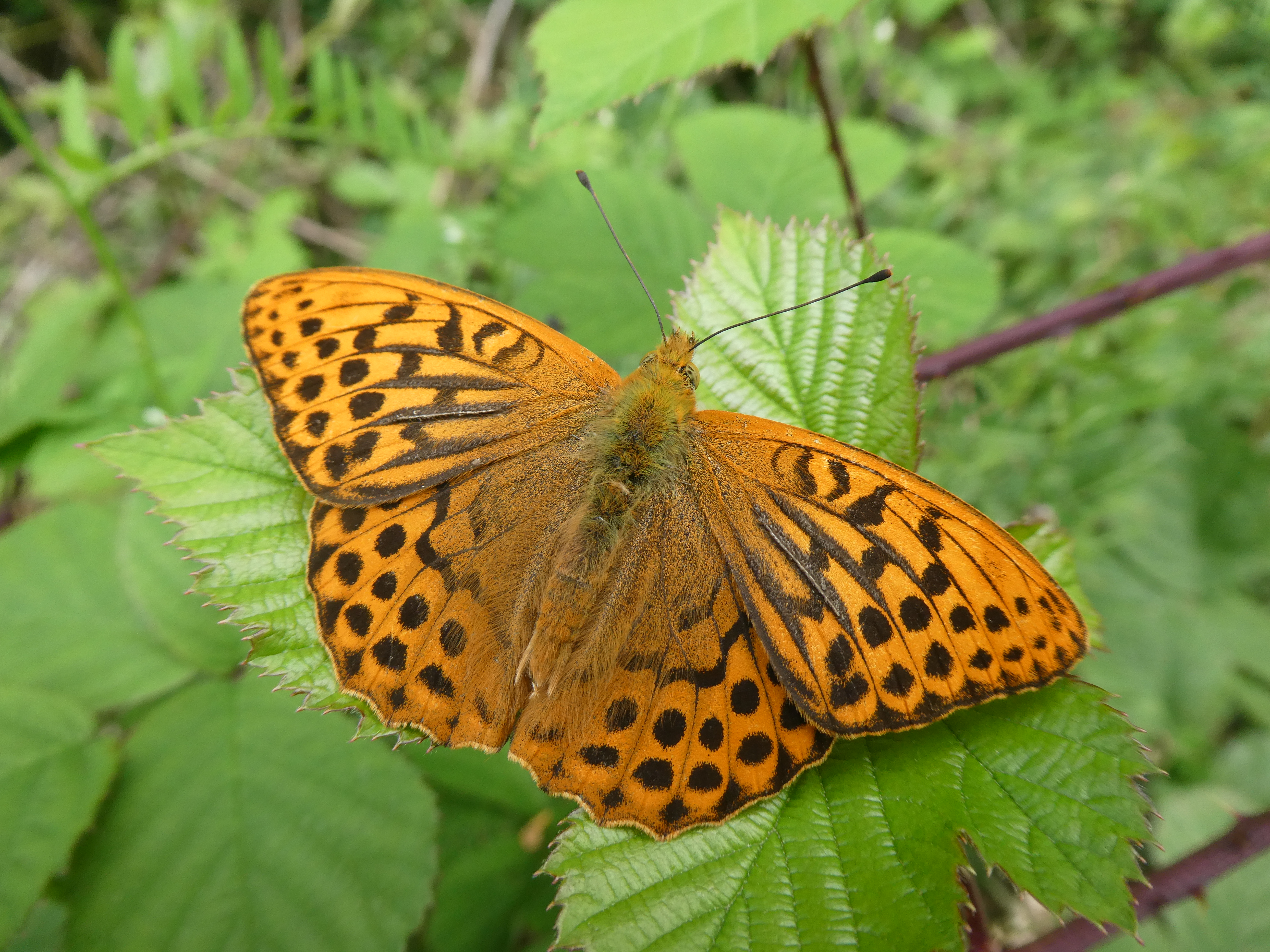
The Comma was reported from gardens in Kilkenny (highest number on one day is five), Carlow (Paul Cutler’s garden), Kildare and Dublin. The Silver-washed Fritillary, not really considered a garden butterfly, presented its stately credentials in just one garden, Robert Donnelly’s, although it has been recorded in other recorders’ gardens in previous years. The Small Tortoiseshell, Peacock and Red Admiral were well represented in most gardens but the Painted Lady, ubiquitous in 2019, appeared in smaller numbers in fewer gardens. A boom-and-bust pattern in this migrants’ appearance in Ireland is the norm!
Other less common garden visitors in 2020 were the Cryptic Wood White, Small Copper and Common Blue (a low-flying grassland breeder which contrasts with the high-flying hedgerow-inhabiting Holly Blue).
Regarding the brown family, the Meadow Brown, Ringlet and Speckled Wood were found in most gardens but numbers varied; the Speckled Wood is territorial in the male so numbers in most gardens will be low; the Meadow Brown and Ringlet are more social and much more tolerant of their own kind, allowing numbers to build if the habitat is sizable and suitable. Because the Meadow Brown is less specialised, occurring in open and partly shaded areas, in long and short swards, it is often more numerous in gardens; Jesmond Harding had a peak count of 10 Meadow Browns but just single Ringlets. With the right mix of grassy habitats, and space for these, more can be achieved. Peak counts of 22 Ringlets and 13 Meadow Browns were made by Robert Donnelly.
The earliest garden butterflies in 2020 were the Peacock and Small Tortoiseshell seen on March 3rd. The last butterfly reported from a garden in 2020 was a Red Admiral seen on October 23rd. Some recorders sent notes of other notable species; Pat Bell, Maynooth, was very lucky to record a Currant Clearwing, a rare day-flying moth. Pat also had the Cinnabar moth, Hairy Dragonfly and Migrant Hawker in his garden. Habitat mosaics, where a range of habitats are built together pays off when you want to cater for as many species as possible.
And with the ravaging of our natural and semi-natural habitats, that approach to gardening for nature is increasingly important. A pond and associated wetland will be used by a range of animal groups including dragonflies, amphibians, hoverflies as well as butterflies and moths. With the climate models showing longer periods of dry weather in spring and summer, species that breed in damp grassland may become highly dependent on permanently wet areas for survival. The Green-veined White and Orange-tip will become increasingly needful of marshy ground. In short, they will need our help. The great pioneer of wildlife gardening, professor Chris Baines, commented that a garden without a pond is like a theatre without a stage. An unshaded pond and wetland, stocked with native plants will generate great activity in your garden. Make this your conservation project in 2020.
Butterfly Conservation Ireland members often go even further to care for their garden butterflies. This description from Jane Doughty is inspiring:
“Just thought we would share with you our efforts here at Little Eden to encourage the survival and increase of the tortoiseshells in our environs.
We collect any hibernating butterflies from the house and sheds and place them safely in a secure box in an outside building where temperatures are cool and they are safe from predators. Early in March, when we note the first sighting in the garden, we release them. Last spring, we released approximately 50.
We had over the years noticed larvae on fresh nettle growth, so now in early June we now cut back 60 to 70% of our nettles, being watchful for eggs or larvae of other butterflies. We provide some photos of larvae numbers.
As we have plentiful plants providing nectar, we find many varieties and particularly the Small Tortoiseshell are prevalent in the garden. Favourite plants are nepeta, verbena, buddleja, eupatorium, knapweed, Devil’s-bit scabious and the good old dandelion to name but a few. In fact, our choice of plants in both the garden and meadow is mostly for the benefit of insects generally. Your post regarding the carder bee made us notice the sterling efforts made to collect the down from the Verbascum (Mullein) leaves.”
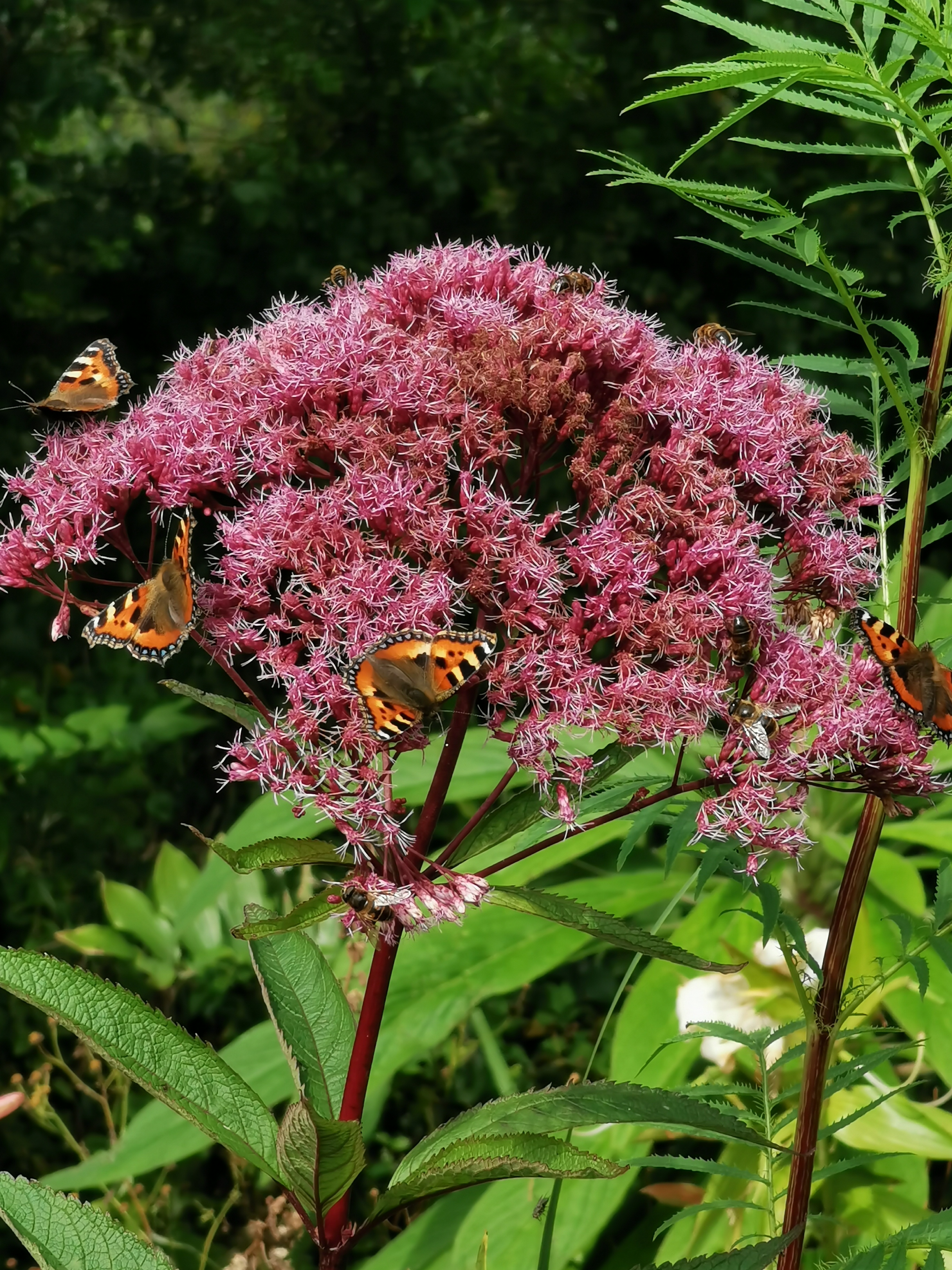
Get Involved
We hope to expand the garden recording scheme further in 2021. Our website www.butterflyconservation.ie contains information about butterfly gardening; click on the “Butterflies” tab and select “Gardening for Butterflies” for details. The survey form can be downloaded from here but if you need a hard copy please request one by emailing us at conservation.butterfly@gmail.com or by letter to Butterfly Conservation Ireland, Pagestown, Maynooth, County Kildare. If you have any doubts about the identity of any butterfly check our Gallery by clicking on the “Butterflies” tab. Thank you for taking part in the scheme and please continue your recording. Recording begins again in March and here’s hoping for a good season in 2021.
Species Focus: Narrow-bordered Bee Hawk-moth
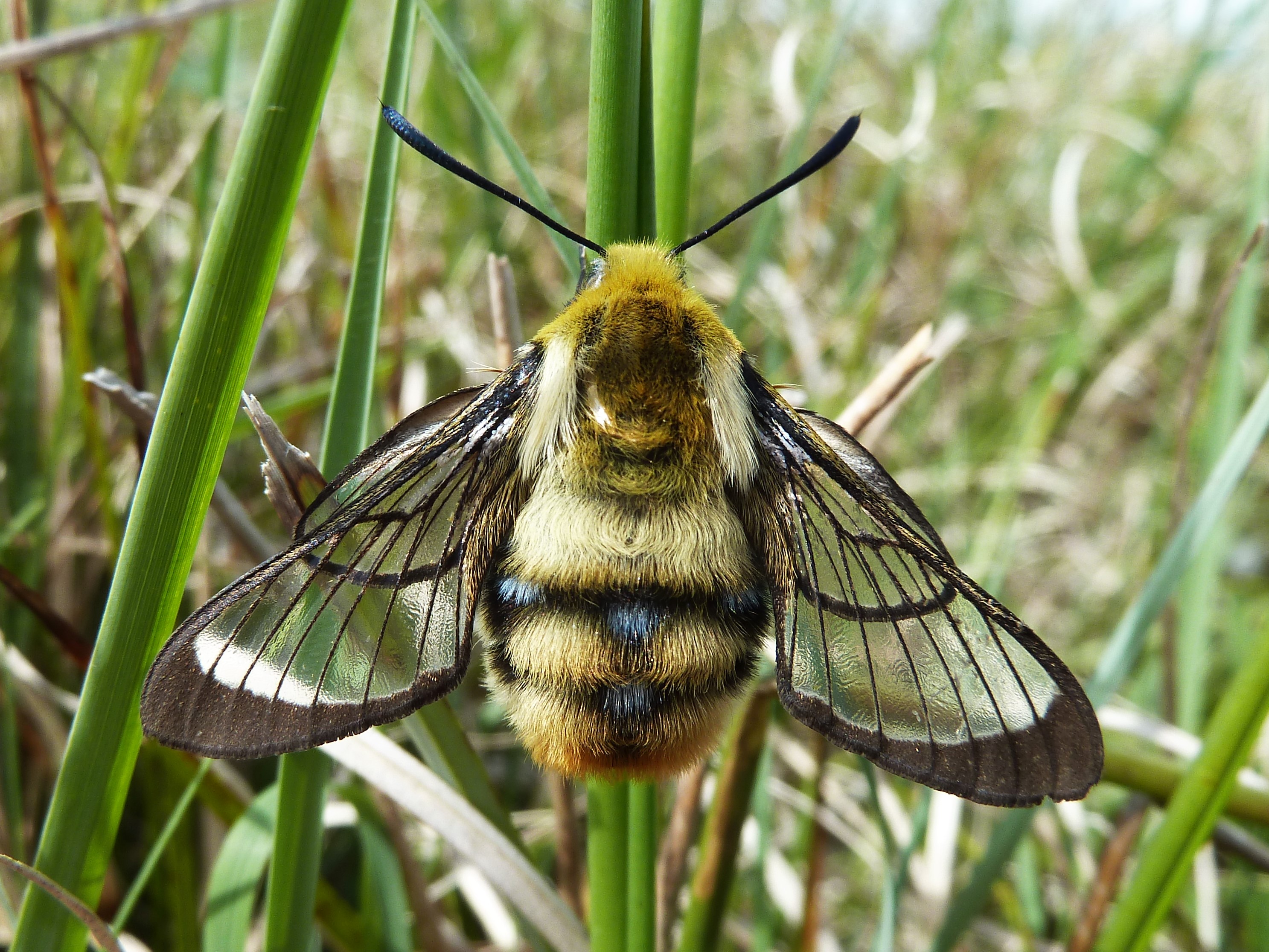 A freshly emerged Narrow-bordered Bee Hawkmoth. Photo J. Harding
A freshly emerged Narrow-bordered Bee Hawkmoth. Photo J. Harding
The Narrow-bordered Bee Hawk-moth is famous for its bee mimicry. A day-flyer, this moth is active but elusive and easily confused with bumblebees, especially with Buff-tailed and White-tailed Bumblebees. Why does it resemble bees? How does it resemble bees? What are its habits, life-cycle and how is it performing in the modern landscape? This article looks at these questions.
The Narrow-bordered Bee Hawkmoth Hemaris tityus is an example of a Batesian mimic. In 1862, Henry Walter Bates published a scientific paper in which he proposed that edible butterflies occasionally produce mutations with visual characteristics that are similar to those of unpalatable, toxic species. He suggested that their similarity would make them less vulnerable to birds, and that their characteristics were more likely to be passed on to their offspring. Bates proposed that certain palatable species thereby evolved to closely resemble their toxic models. For the palatable Narrow-bordered Bee Hawkmoth, Batesian mimicry works because it is outnumbered by unpalatable, toxic bumblebees.
With its glassy wings, furry body, thickset appearance, short, thick antennae and body colour, the moth certainly looks bee-like. If you are still unsure of its bee imitation credentials, the moth makes a buzzing sound and flies in a fairly determined linear manner (mostly). It also regularly visits flowers although, unlike a bee, it does not settle on the flower but takes nectar by dipping its long proboscis into the bloom while it hovers. For a bird, this may not be compelling proof of its unpalatability but it buzzes loudly as it feeds. Safer to steer clear!
Despite the moth being a resident, day-flyer, it is seen by few people. It flies in a single generation, usually from mid-May to early July but in a warm spring, such as 2003, 2009 and 2011, it will fly as early as April. I remember my amazement on seeing extraordinary numbers in the Burren in April 2009, visiting Primroses and mingling with Brimstone, Pearl-bordered Fritillary and Dingy Skipper butterflies. Because I am accustomed to seeing the moth a month later, when the vegetation looks very different, their mass emergence in 2009 was particularly surreal. Even a common insect looks strange when you see it at the ‘wrong’ time or place. The adult moth typically feeds on Common Dandelion, Common Bird’s-foot-trefoil, louseworts and Bugle.
 Narrow-bordered Bee Hawk-moth egg on Devil’s-bit Scabious leaf.
Narrow-bordered Bee Hawk-moth egg on Devil’s-bit Scabious leaf.
This moth is specialised on just one breeding plant, the Devil’s-bit Scabious, which is also used by the Marsh Fritillary butterfly. However, while it breeds on the same sites as the Marsh Fritillary, it prefers to breed on plants growing in shorter grass. While it is often associated with damp grassland and dry or damp grassy heaths it breeds happily on dry calcareous grassland and machair grassland.
It flies in the sunshine and rests when it is cloudy or during very hot weather. Females lay their eggs singly, on the upper surface of the leaf of a Devil’s-bit Scabious plant growing among a grassy sward, usually or always in an unshaded location. When it hatches the caterpillar is pale green throughout, except for a pink ‘horn’ at the end of the abdomen. However, after undergoing a series of moults, it becomes a deeper green, marked strikingly with purple markings along its back, sides and undersides, helping it to blend with the purple markings and blotches that are frequent on the stems and leaves foodplant in mid-summer. When the caterpillar reaches its full length at 38-45 mm in July or August, it buries itself in loose soil near the foodplant and forms a black pupa, a great colour match for peat soil.
The moth over-winters as a pupa and the adult emerges during the following spring or summer, according to the weather.
This incredible moth is rated as Least Concern on Ireland’s moth red list published in 2016. However, the moth is uncommon across most of Ireland, being generally local except in the Burren. It is scarce in the southern counties, eastern coastal counties and in Northern Ireland. In Britain it is regarded as nationally scarce, with it being more widely distributed in Scotland. In 2019, the moth was seen in the Brecon Beacons in Wales, for the first time in a hundred years. It was also recorded in the Vale of Glamorgan in 2019, for the first time since 1935. It also appeared in Cornwall after a ten-year absence. This recent rise in sightings has been linked to the excellent weather during the summer of 2018 which helped this usually local species to disperse in search of new breeding grounds. Its scarcity is due to habitat loss with many of its sites simply ploughed up, or changed by using fertiliser, by switching from hay to silage production or by being used for forestry. Higher stocking rates on grazing land, the switch from cattle to sheep grazing eliminates the sward conditions needed while land abandonment which causes grassland to develop scrub and eventually woodland also results in population losses.
 Narrow-bordered Bee Hawk-moth larva.
Narrow-bordered Bee Hawk-moth larva.
If you want to get a good view and photo of the resting moth, visit its habitat in May in the morning before the heat rouses it. The walks cut through the hazel scrub in the Burren National Park, County Clare, the open grassland on the east side of Dunshane Common, County Kildare and the Irish Peatland Conservation Council reserve in Lullymore, County Clare, are good sites for this species. It has also been recorded on Bull Island, towards the northern end, near the famous ‘Alder Marsh’. There are many sites for it in Donegal, such as St John’s Point, in South-west Donegal. Any site that contains a high density of the breeding plant, Devil’s-bit Scabious, is well worth a look. Don’t forget to keep an eye open for the striking caterpillar in mid-summer.
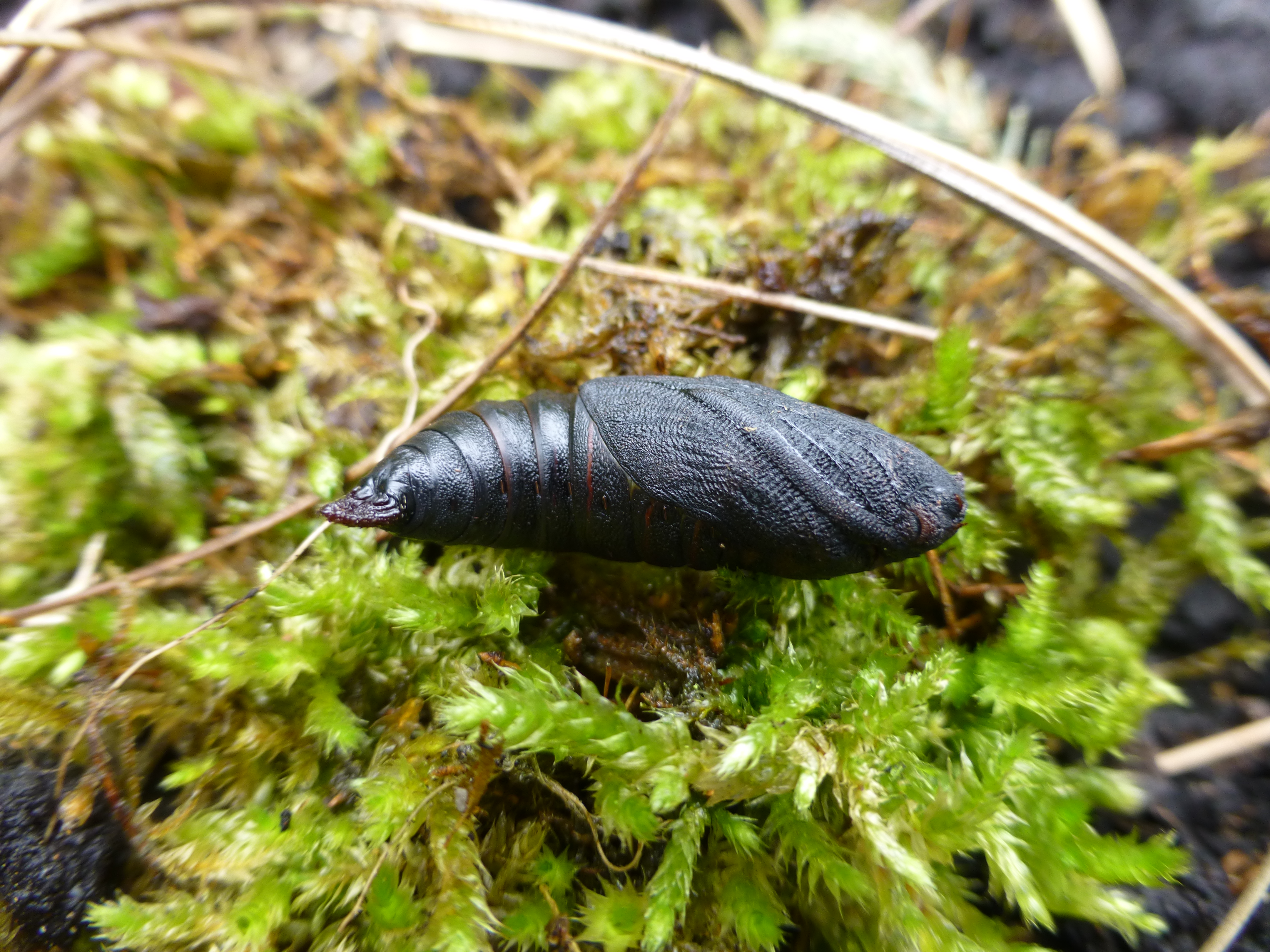 Narrow-bordered Bee Hawk-moth pupa.
Narrow-bordered Bee Hawk-moth pupa.
Despite the moth’s charms, someone, it seems, did not like it. Its species name is tityus, named after the giant Tityos, a son of Zeus. As an unborn baby, he split his mother’s womb. When adult-sized, his body covered nine acres. Tityos was punished in hell for an attack on a goddess, Leto, by a pair of vultures who pecked everlastingly at his liver. His liver would regenerate at night and his punishment would resume the next day! Its genus name, Hemaris, is a Greek word for day, a more descriptive word for this day-flying moth.
References:
Allen, D., O’Donnell, M., Nelson, B., Tyner, A., Bond, K.G.M., Bryant, T., Crory, A., Mellon, C.,
O’Boyle, J., O’Donnell, E., Rolston, T., Sheppard, R., Strickland, P., Fitzpatrick, U., & Regan, E.
(2016) Ireland Red List No. 9: Macro-moths (Lepidoptera). National Parks and Wildlife Service,
Department of Arts, Heritage and the Gaeltacht, Dublin, Ireland.
Marren, P. (2019) Emperors, Admirals & Chimney Sweepers. Little Totter Books, Dorset.
‘Moth returns after 100-year absence; Nature notes’ (2019) Daily Telegraph [London, England], 04 Sep, 33, available: https://link.gale.com/apps/doc/A598296790/STND?u=nuim&sid=STND&xid=86f5e4df [accessed 13 Jan 2021]
https://butterfly-conservation.org/moths/narrow-bordered-bee-hawk-moth accessed January 13, 2021
http://www.mothsireland.com/ accessed January 13, 2021
Dixon, M. (2019) ‘Rare moth returns to Cornwall for first time in ten years’, Falmouth Packet [Falmouth, England], 08 Oct, NA, available: https://link.gale.com/apps/doc/A602007169/STND?u=nuim&sid=STND&xid=15a18393 [accessed 13 Jan 2021]
Some Notable Butterflies in South Korea
Dongjun Cha and Michael Friel
South Korea occupies the lower half of the Korean Peninsula. Its area is 20% larger than Ireland’s, and it has about 206 butterfly species, excluding occasional migrants. The whole peninsula has some 260 species, about the same as Italy, despite being 25% smaller; and Italy has the largest number of species in Europe. This data may come as a surprise to some. However, a number of factors have favoured the continuing survival of a varied butterfly population. North Korea remains inaccessible, so we shall look here only at our home country, South Korea.
South Korea has China to the west, N-E China and the Russian Far East (via North Korea) to the north, Japan to the east, and Taiwan and the Philippines far to the south. This location makes for an interesting mix of temperate and sub-tropical species. While South Korea only has one endemic, Favonius koreanus (related to the Purple Hairstreak butterfly found in Ireland), it has some species not found in one or more of its close neighbours, including rarities. The north of the country has more species than the south, but several species are only found in the latter. Some of these are recent arrivals, and some are slowly spreading north.
The country is predominantly mountainous in the northern part. The high mountain chain on the eastern side splits in two, running south-east and south-west down to the south coast. The west is lipaflatter and more agriculturally developed, but in general South Korea is a land of dark forested hills and mountains, many over 1200m high. Visitors are quickly struck by the number of trees wherever they travel; in fact, 64% of the country is forest-clad, thanks to large reforestation programmes which took place after the Korean War.
The climate is temperate, with very cold winters in the north (down to -20 Celsius), milder winters in the south, and much hotter summers than in Ireland throughout the country. There is plenty of sunshine in spring and autumn too. Rain falls mainly in July and August, when typhoons sometimes blow in vagrant species from the tropics. So, location, topography and climate are three of the main factors for species diversity in South Korea.
Favourable habitats for butterflies include the following:
a) Woodland roads: old, unpaved roads are common, providing access – and sustenance – to many species
b) Damp grassland: areas beside rivers and reservoirs (including the tops of grassy dams), and Ramsar sites (wetlands protected under the Ramsar Convention 1971).
c) Dry grassland: there are very few meadows, but dry areas in National Parks have some rare species.
d) Open hilltops and ridges: parts where the newer forests have not taken hold can provide prime habitat.
e) Calcareous regions: most extensive in the north-east, these provide excellent conditions for many species.
f) Cultural sites: countryside graves are ubiquitous, and may be covered with wildflowers; temple grounds can preserve rare trees and bushes, and also offer puddling sites (wet ground where butterflies find mineral salts and moisture).g) Gardens and urban parks: not nearly as common as in Europe, but still offering some rich habitat.
Here are just a few of the more interesting and colourful butterflies to be seen, in approximate order of their first occurrence in the year.

Luehdorfia puziloi : This beautiful butterfly welcomes in the Spring around the last week of March. The male adults appear a few days before the females, often between 400 and 600m above sea-level. They start by feeding on the early violets, and later on the wild pink azaleas and mauve Asian fawn lily. In early May they end their lives in the search for more wide-ranging nectar sources. In these few weeks they will have mated, the male often attaching a sphragis or mating plug to the female’s abdomen, like other members of the Parnassiinae subfamily. She will lay her eggs on Asarum sieboldii, or wild ginger. This butterfly usually flies quite close to the ground, pausing for the occasional feed, and finally takes a rest around 4pm, basking on or near woodland paths. Its mottled colouration can make it difficult to spot against the old brown vegetation. It is distributed in the Russian Far East, Manchuria, the Korean Peninsula and Japan.
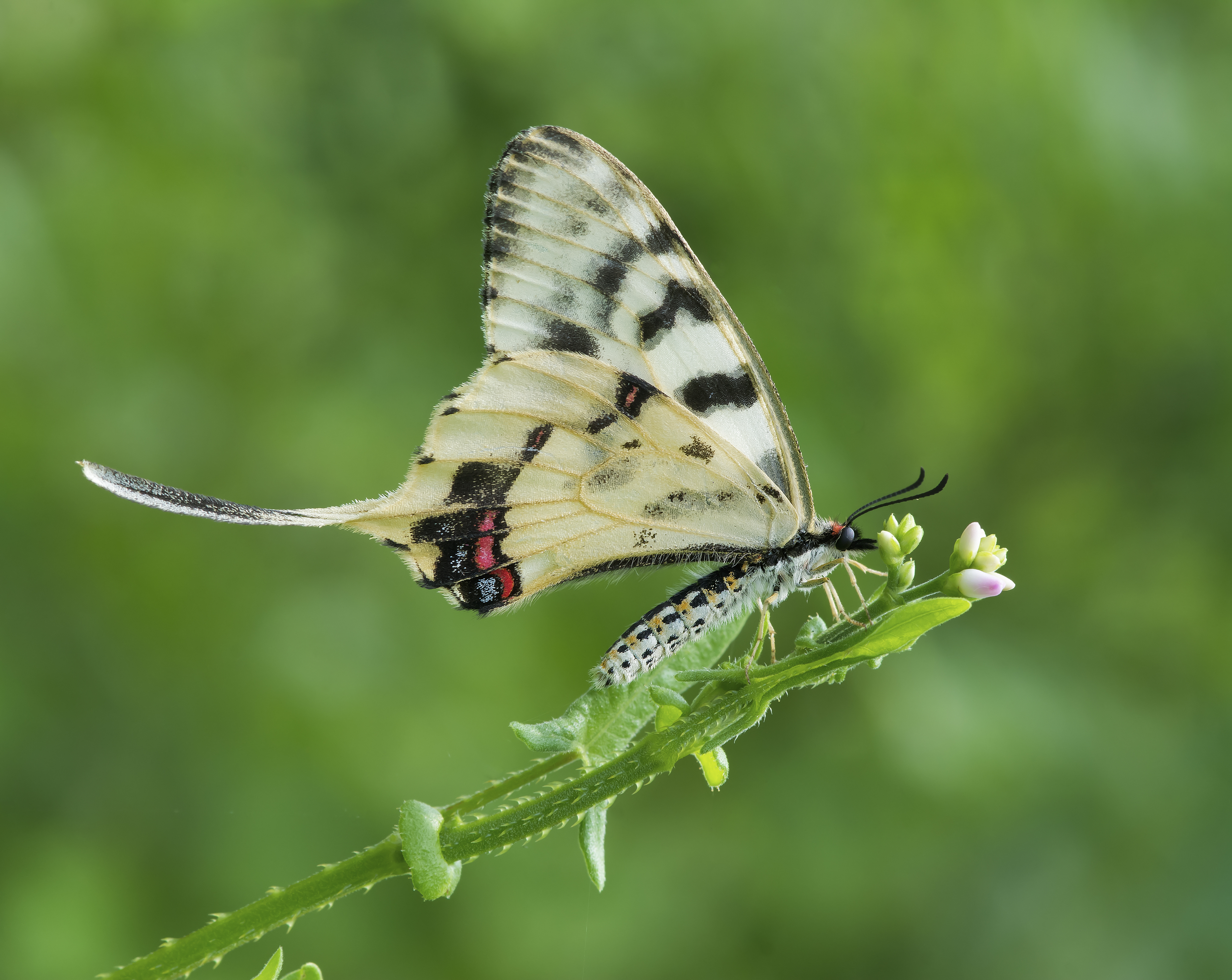
Sericinus montela (above): The monotypic (a genus with just one species) Dragon Swallowtail has three broods, between late March and September. Not only are the sexes dimorphic (differing in appearance), but the spring form has more red markings in both males and females. It can be found nationwide, near where the larval host plant, Aristolochia, grows, in grassy areas close to water or forest. Often a group of cream-coloured males is found flying around non-stop with a slow flap-and-glide as they seek out females. They finally alight vertically on blades of grass as the sun sets.
The dark and less visible females are seen at their best around first mating. They may sometimes be found in a lek with the males circling one of the countryside grave clearings. As the larval food plant is low, it is not difficult to observe the mating and egg-laying of this exquisite species. The Dragon Swallowtail also inhabits the Russian Far East and China and it recently occupied Japan.
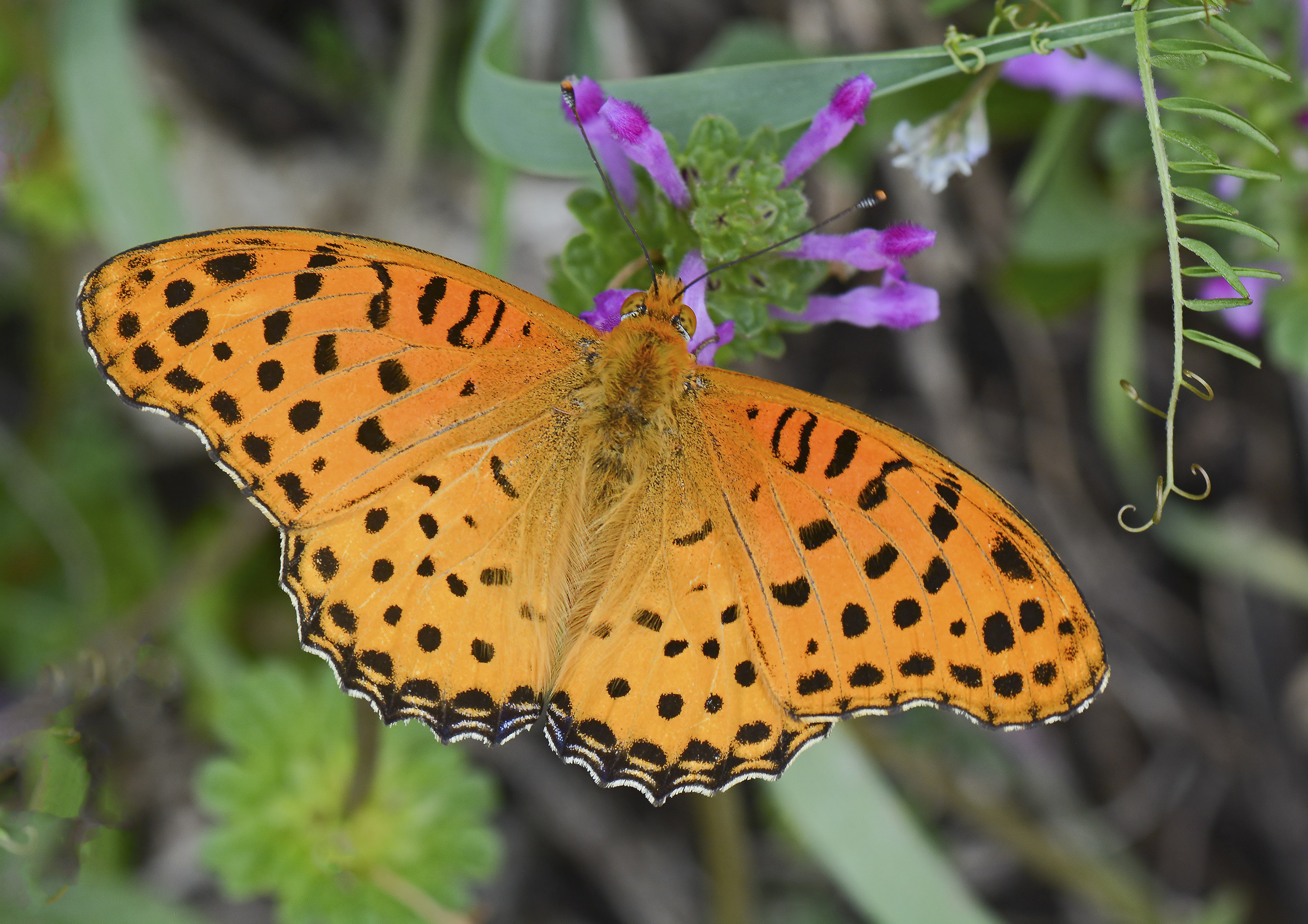
Argynnis hyperbius : The Indian Fritillary is South Korea’s largest fritillary. It is very common in southern and western coastal areas, where it has 3-4 broods between late March and November. It seems to be extending its range northwards and inland as the climate warms. It is dimorphic, the larger female being particularly striking with its upper forewing apical markings. Both sexes have richly-patterned underwings.
On sunny days they can be seen for several months in Michael Friel’s garden, where, after a lively flying courtship, they often choose an attractive flower on which to mate. In fact, they oviposit in the garden too, as there is a good supply of the larval host plant, a species of Viola (violet). Adults feed on a broad range of nectar-containing flowers, both in gardens and in the wild. This strong-flying fritillary is globally widespread, from Ethiopia to Australia, preferring the warmer regions.
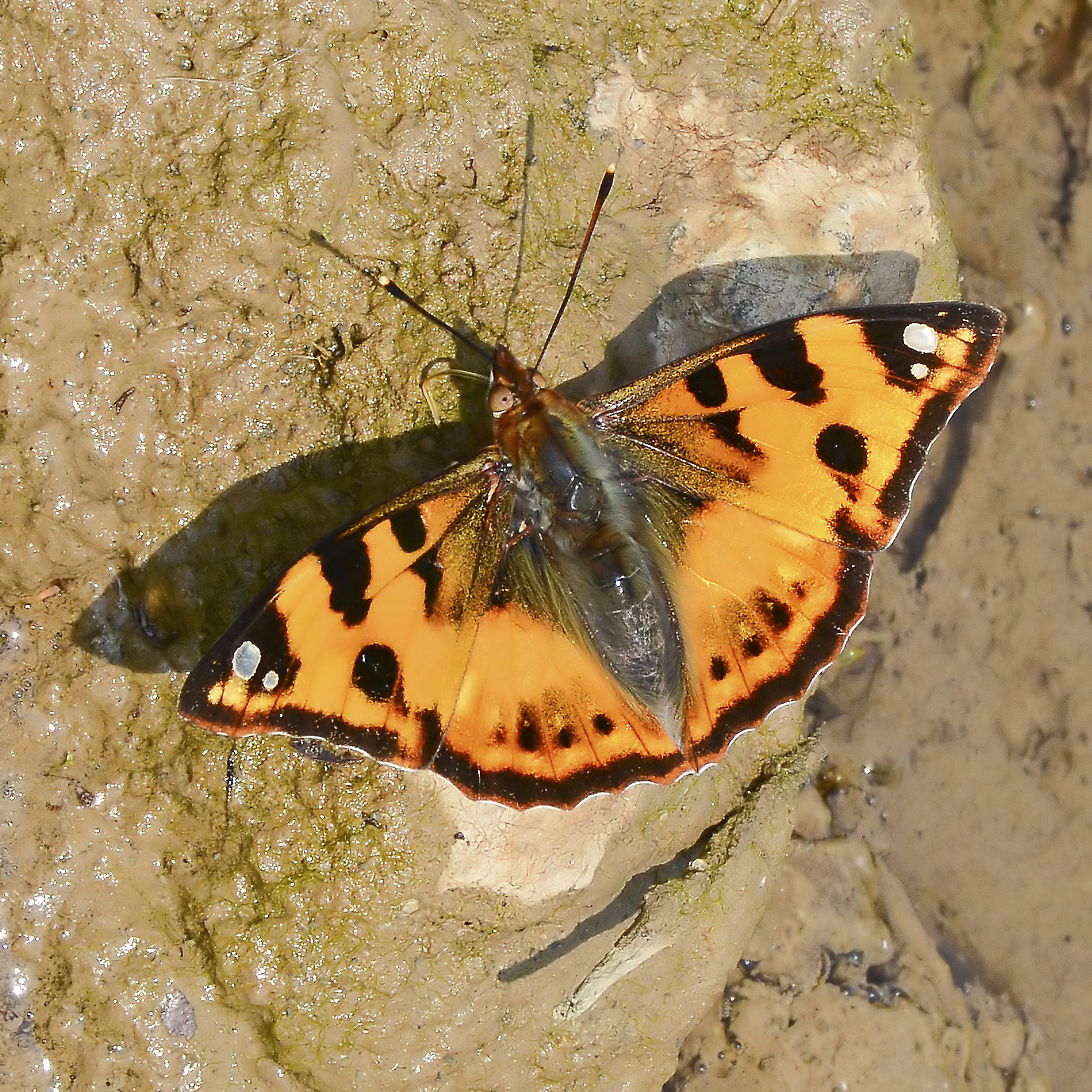
Dilipa fenestra: The Window Emperor is a Nymphalid found in China, Far-eastern Russia and Korea. The larval food plants are species of the genus Celtis. The adult flies once a year from April to June. On the apical area of the forewing, it has two little transparent spots, hence the words “window” and “fenestra” in the English and Latin names. It has sexual dimorphism; the male’s prevailing colour is strongly golden, while females are dark brown, similar to the colour of the earth.
Males have a habit of coming down to the ground near a stream on a sunny morning, and they gather in numbers on the dung of wild animals. They do not nectar on flowers. In this respect, they resemble the Purple Emperor Apatura iris found in southern England and mainland Europe. In the afternoon, they show active occupation behaviour on high branches. Knowing the location of favoured habitats makes it easy to find groups of males each year, but it is very difficult to see females. The females of butterfly species that breed in trees are often highly elusive; in some species the males are seen every season but the females are not.

Choaspes benjaminii: The Indian Awlking is South Korea’s most colourful skipper, with striking gunmetal underwings and a bright orange tornal area (inner angle of the wing) easily visible in flight. It is bivoltine (has two generations a year), with the first adults emerging in late April to nectar at lower levels on wild raspberry flowers; the second brood flies in July and August, the males often hill-topping and flying around at high speed in a figure-of-eight pattern. It frequently chooses to rest on the underside of leaves in the heat of the day. Its attractive larva is pale yellow with black bands and an orange head with large black spots. It feeds on species of Meliosma, or Wellingtonia. In South Korea, this skipper is found in the far south, west and north-west. Its range extends across East Asia, from India to Japan.
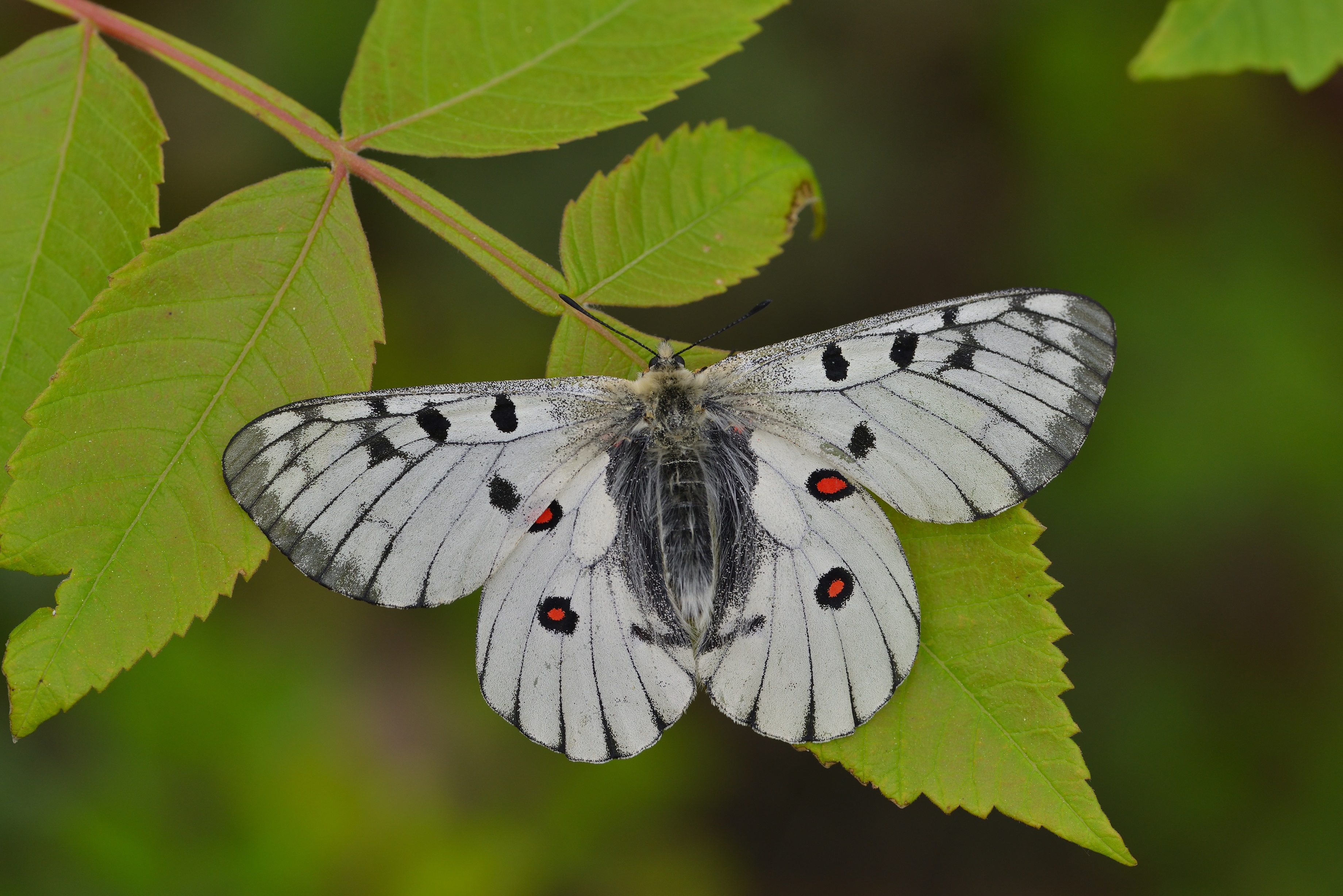
Parnassius bremeri: This species, classed as endangered in South Korea, varies in morphology; northern individuals tend to be smaller than southern ones. It is found in a few small, isolated areas scattered across the country. The habitat consists of unshaded grasslands or dry, rocky areas without many trees. Its larval host plants are species of Sedum. The first instar of the larva hatches in December, while the adult emerges in May or June. It flies with a slow and graceful motion and usually comes to rest with wings closed. The female has more pronounced black and red markings than the male. Like Luehdorfia puziloi, the male may attach a mating plug to the female after copulation. Owing to its relative slowness and restricted habitat, P. bremeri easily falls prey to collectors, despite this being illegal in South Korea. It is also distributed widely over eastern Russia and northern China.
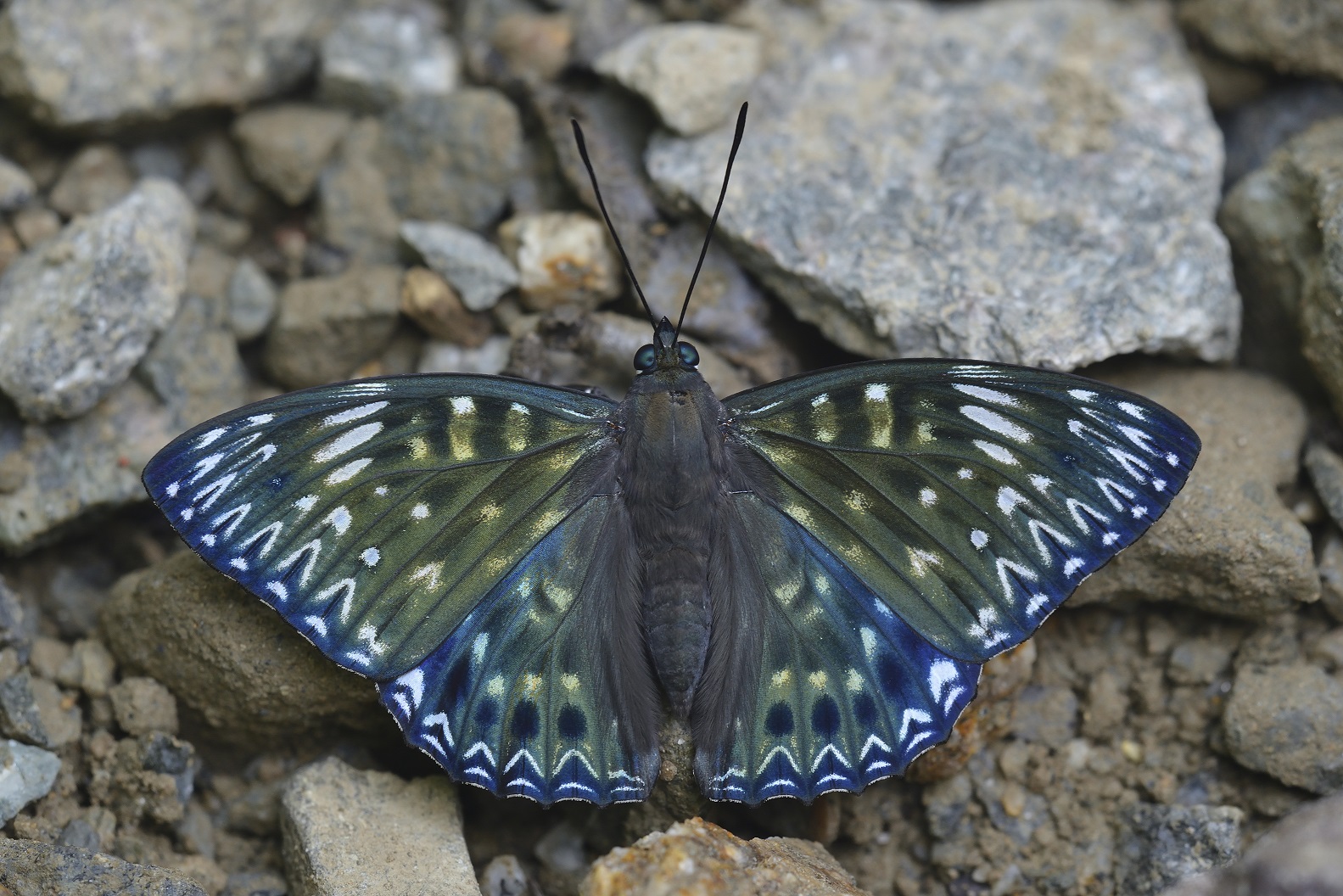
Dichorragia nesimachus: The Constable is a rare example of blue blending seamlessly with green, even in its eyes. The white chevrons and red proboscis further add to its beauty. Underwing the chevrons are just as visible, but on black forewings and dark brown hindwings. This medium-sized Nymphalid has two adult broods, from May to June and from July to August. The male defends its territory vigorously with fast flight in the afternoon from high broadleaf branches, preferring open mountain tops. It descends to lower levels to mud-puddle or feed on tree sap, dung and rotting fruit. Its larva feeds on Meliosma species. The Constable is found in the south and in the north-west, including on small islands, where it basks on the rocks. Its range extends across South-east and East Asia, from India to Japan.
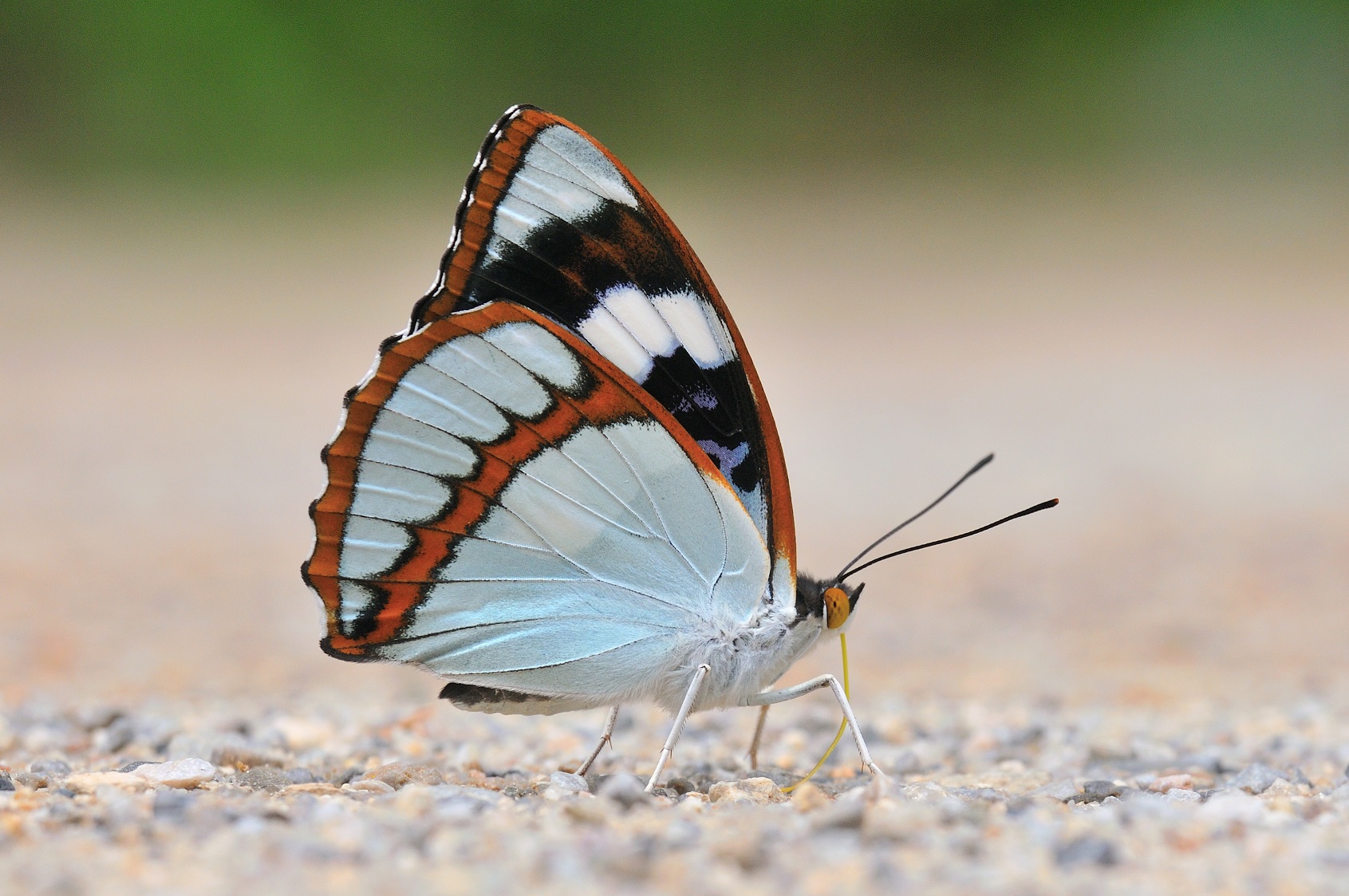
Mimathyma schrenckii: The adult Schrenck’s Emperor flies from mid-June to August. It likes to gather on the faeces of wild animals and to puddle on wet ground. Sometimes it visits manure piles. Four species of the genus Mimathyma are known around the world, and two of these live in Korea. These two are also distributed in Amur, the Ussuri region and North-east China.
The pale blue colour on the forewing upperside, though not strong, gives a very mysterious feeling. In Korean this butterfly is known as silver plate butterfly as it has a broad, silvery-white colour on its underside. It has no sexual dimorphism, but the female is a little larger and has a duller background colour. The larvae of Schrenck’s Emperor feed on the elm family (Ulmaceae), and are very similar to those of the genus Apatura (this is the genus containing the Purple Emperor butterfly); indeed, some taxonomists treat the genus Mimathyma as Apatura.

Cigaritis takanonis: This butterfly, which has beautiful silvery lines on its underside, is the only double-tailed Lycaenid (the butterfly family that in Ireland comprises the blues and hairstreaks) species in South Korea. Due to its limited habitat and small population, it is designated as an endangered species in the country. Adults appear once a year from mid-June to August. They often visit Asteraceae flowers like Annual Fleabane for nectar, and occupation behaviour is brisk at dusk. The females lay their eggs on the stems and leaves of pine, oak and juniper trees around areas patrolled by ants of the species Crematogaster matsumurai. After the eggs are hatched, the ants take the larvae to their colony, where they grow up under the ants’ care. Sometimes they come out of the ant dwelling to bask in the sun; at this time many ants can be seen following and protecting them. In return, the caterpillars produce secretions containing carbohydrates and amino acids, which the ants harvest and consume. C. takanonis is also found in Japan.
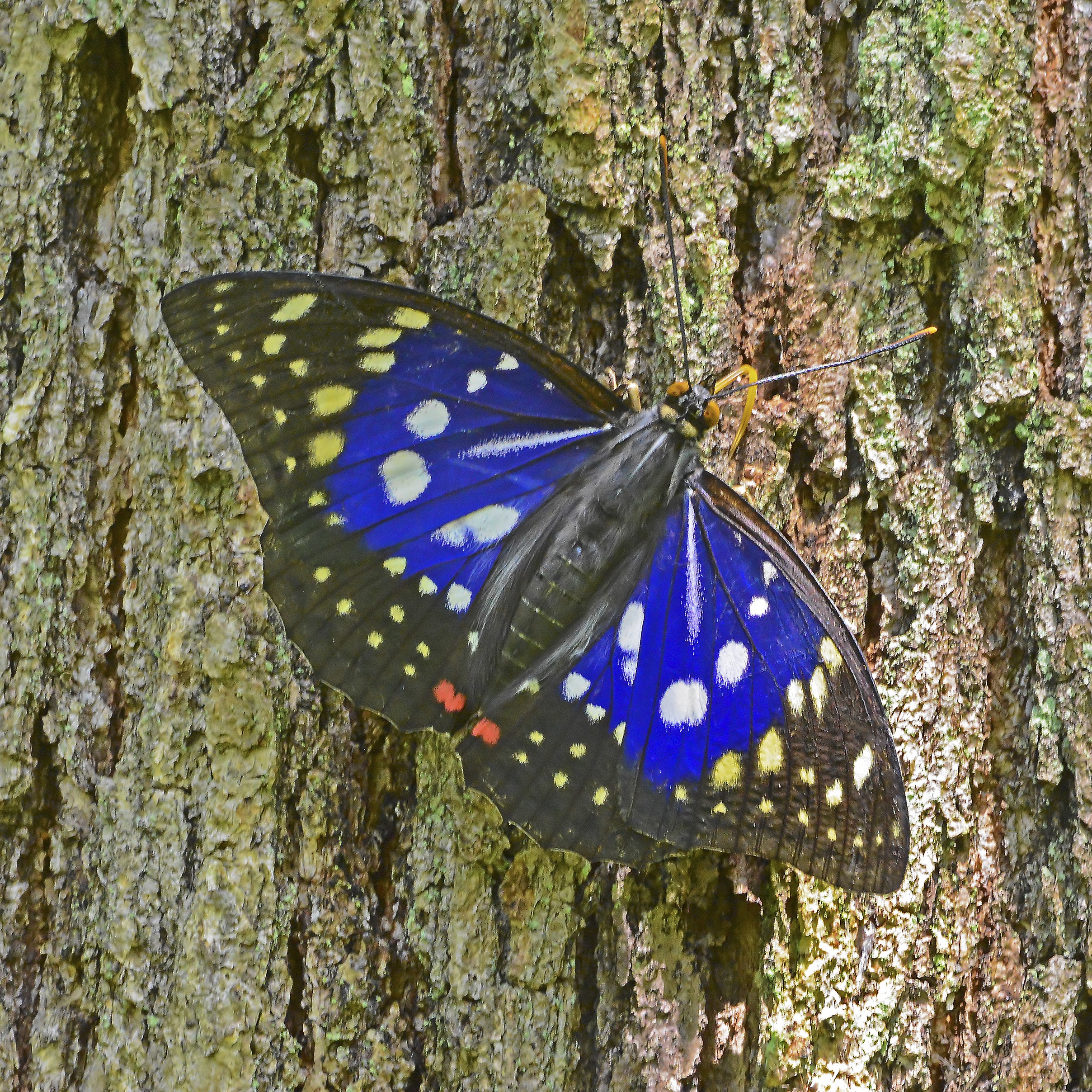
Sasakia charonda: The adult Great Purple Emperor appears towards the end of June in most parts of the country, preferring hilly areas with broadleaf trees. The male is easier to find as it searches for minerals, often from sap rising in the trunks of oak trees. It soon moves upwards to the elevated tree-tops, where it is one of the most graceful and speedy of the hill-toppers, acrobatically challenging any intruders to its territory, even small birds. The female is larger than the male, and can reach a wingspan of 10cm, making it the largest of Korea’s Nymphalidae (the butterfly family that contains the mainly larger colourful butterflies that occur in Ireland, like the Red Admiral). It lacks the male’s brilliant blue and is rarely seen out of the treetops. The larval food plants are trees of the genus Celtis. In Korean this butterfly is known as “king five-coloured butterfly”. Because of its fighting spirit, S. charonda does not stay pristine for very long, and by the end of July is usually the worse for wear, though it remains very active into August. It is also found in Japan, China and Taiwan.
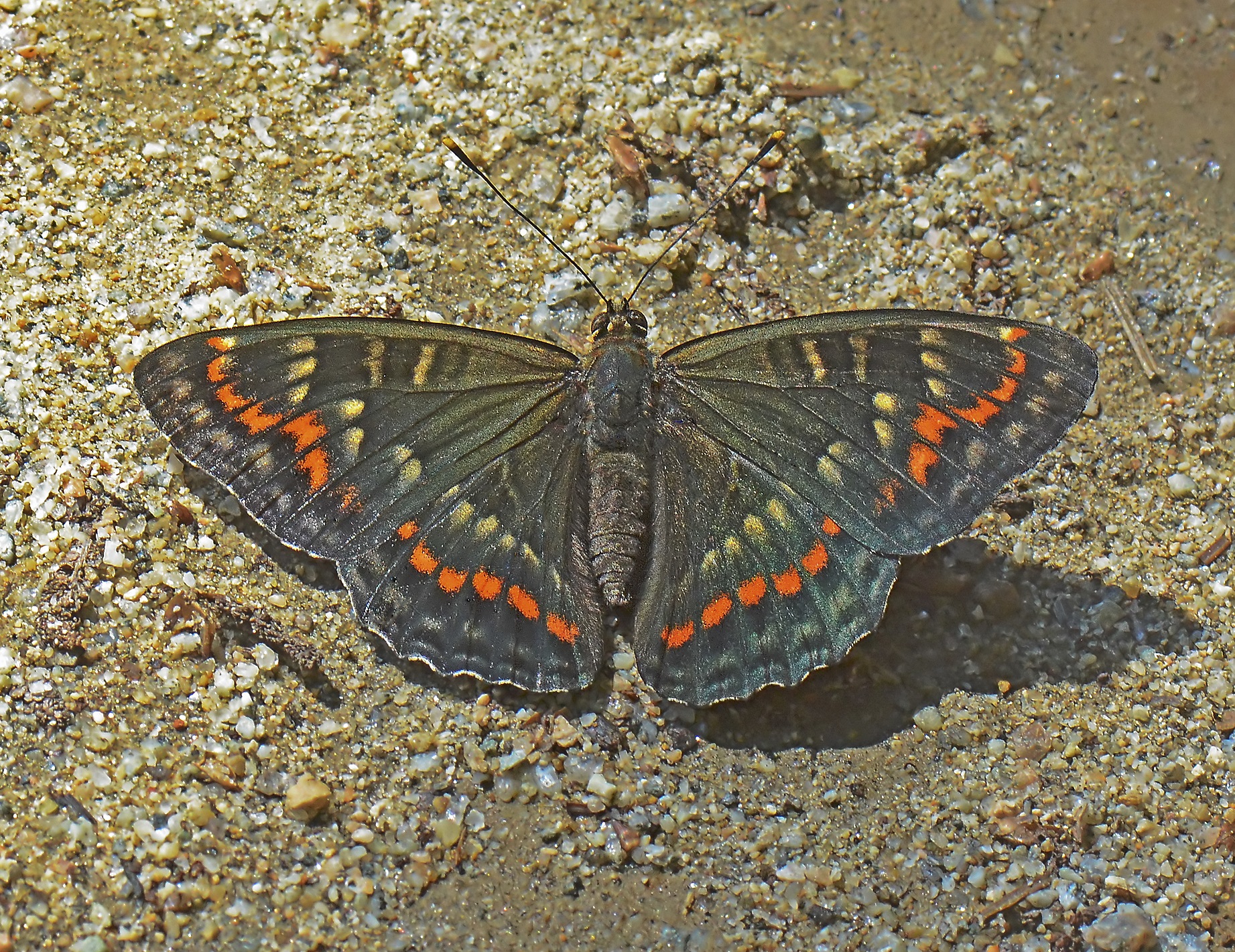
Seokia pratti : This dark beauty was formerly included in the genus Limenitis but now belongs to the monotype genus Seokia. This name is derived from the surname of Korean butterfly scholar Seok Ju-myeong (1908-1950). It was bestowed by the author Sibatani, 1943, as a token of appreciation for samples and help in defining the genus. Found in small areas of eastern Russia, China and the Korean peninsula, it is a very rare species that is locally distributed in the northern part of South Korea. The larval food plant of this butterfly is the Korean Pine Pinus koraiensis.
The adult flies from early July to August once a year and usually comes down to the ground in the morning to imbibe minerals. Because it is a beautiful, unique and rare species, and also because the scholar Seok is very famous and respected by Koreans, this butterfly is very significant in Korea. It is not an endangered species, but it is protected from collectors because its most important habitat is inside a national park.
Practicalities: The best months for seeing butterflies in South Korea are from April to July, with June the peak month. September and October still provide some 40 species in the south, but June will easily have four times that number nation-wide, including many of the rare species. Mid-July to August is usually very rainy. A visit to both the southern area (where Michael Friel lives) and the northern part (where Dongjun Cha lives) is recommended for the best spread of species. Jeju Island off the south coast may also reward a visit, as it has a few species not found elsewhere in the country. Public transport is excellent everywhere, while restaurants and hotels are cheaper than in Ireland. The major cost is the airfare, so combining South Korea with Japan, a short hop away, might be a good proposition. Both the authors would be very willing to help out members and friends of Butterfly Conservation Ireland if they are persuaded to make the trip to this adventurous, but very safe, destination.
For further information, please contact Michael Friel: mwfriel@hotmail.com
Sources:
Paek, M-k and Shin Y-h. (2011) Butterflies of the Korean Peninsula, Nature and Ecology, Seoul.
Haahtela, T., Saarinen, K., Ojalainen, P., and Aarnio, H. (2011) Butterflies of Britain and Europe, A & C Black, London.
Editor’s acknowledgement:
I wish to thank Michael and Dongjun for bringing us the amazing photographs and lucid, descriptive text on the butterflies of South Korea. Their work provides a glimpse of the wonders that lie beyond our shores and encourages further study and travel when travel becomes possible again. J. Harding
PATRICK SHERIDAN: AN APPRECIATION
Butterfly Conservation Ireland is deeply saddened by the passing in December 2020 of one of our members, Patrick Sheridan, known by his friends as Paddy. Paddy is survived by his loving wife, Sandra.
Paddy was a remarkable conservationist who battled fiercely for nature. No cause was too small for Paddy’s attention. He worked with extraordinary energy and passion for conservation causes, especially in his beloved County Kildare. Paddy had a remarkable capacity to learn about a range of animal groups, be it butterflies, birds, amphibians, bats or mammals, absorbing detail with a rarely matched enthusiasm. Paddy was involved with Butterfly Conservation Ireland at an early stage, working hard at conservation work parties, barely lifting his head until his patch of turf was fully attended to, with not a scrub sapling remaining to encroach on flower-rich grassland.
His success in recording the presence in County Kildare of birds and butterflies stands as a great testament to his tenacity and team-building skills. Enhancement measures such as the erection of Swift, Barn Owl and Dipper nest boxes in suitable areas in the county were pursued. When Paddy realised there were deficiencies in conservation effort of biodiversity across the Country Kildare, he single-handedly gathered together a group of like-minded enthusiasts and formed Wild Kildare. The aim of Wild Kildare is to build up awareness of all wildlife and most importantly, all habitats in County Kildare.
At his home, too, Paddy cared for nature. Birds were fed and watered, butterflies and moths given breeding habitat, neighbours prevailed on to spare nettles. Nothing was beneath his notice.
Paddy will always be remembered for his care for nature. No-one who met Paddy could say he went for any commitment less than total. His life was cut very short, but Paddy will be delighted to see Kildare’s peatlands being restored, and hopefully, the Curlew returning to breed.
He deserves no less.
Paddy, may you rest in peace.
